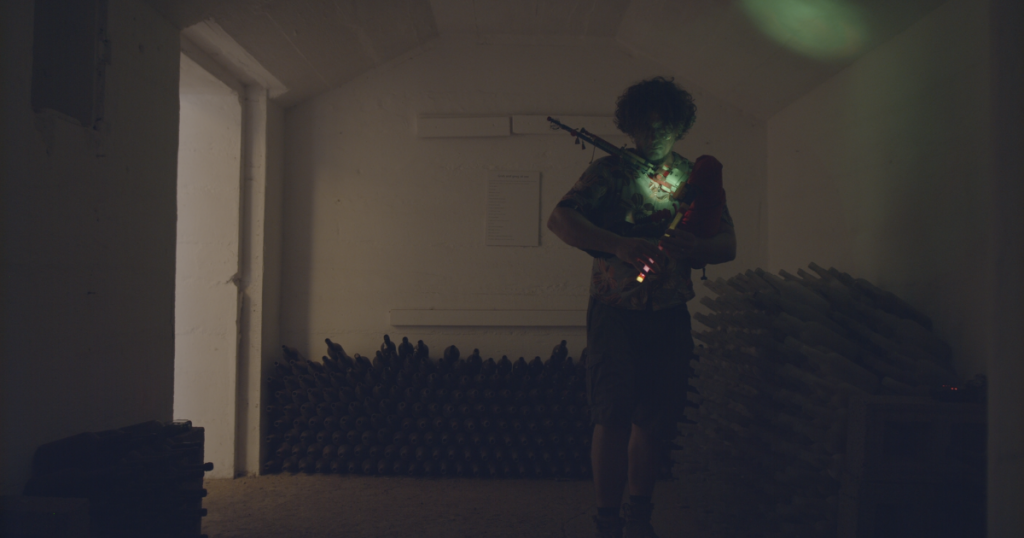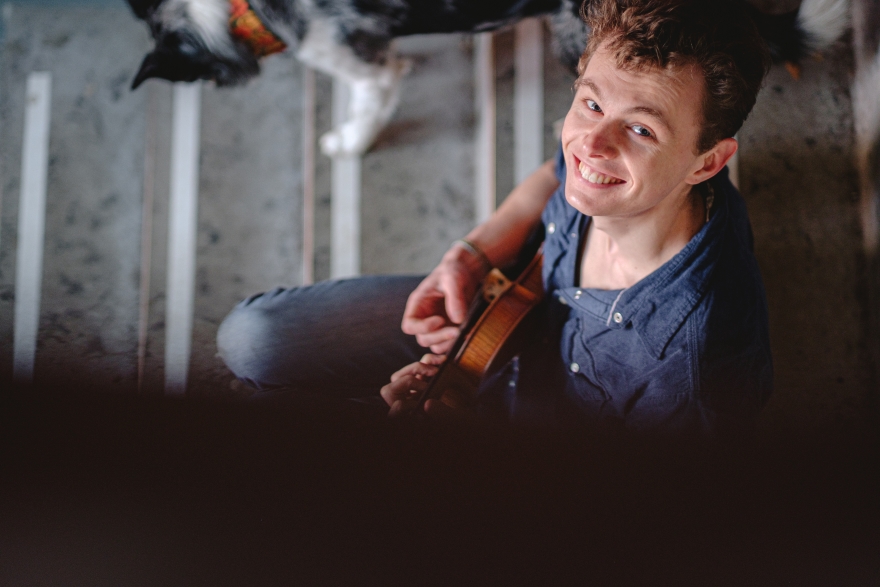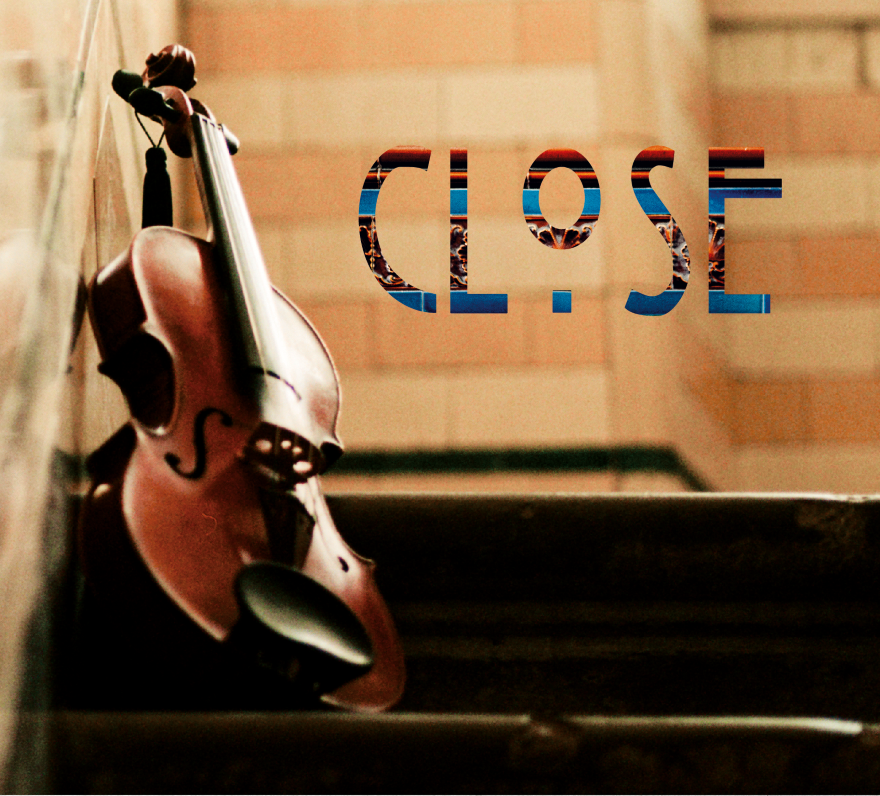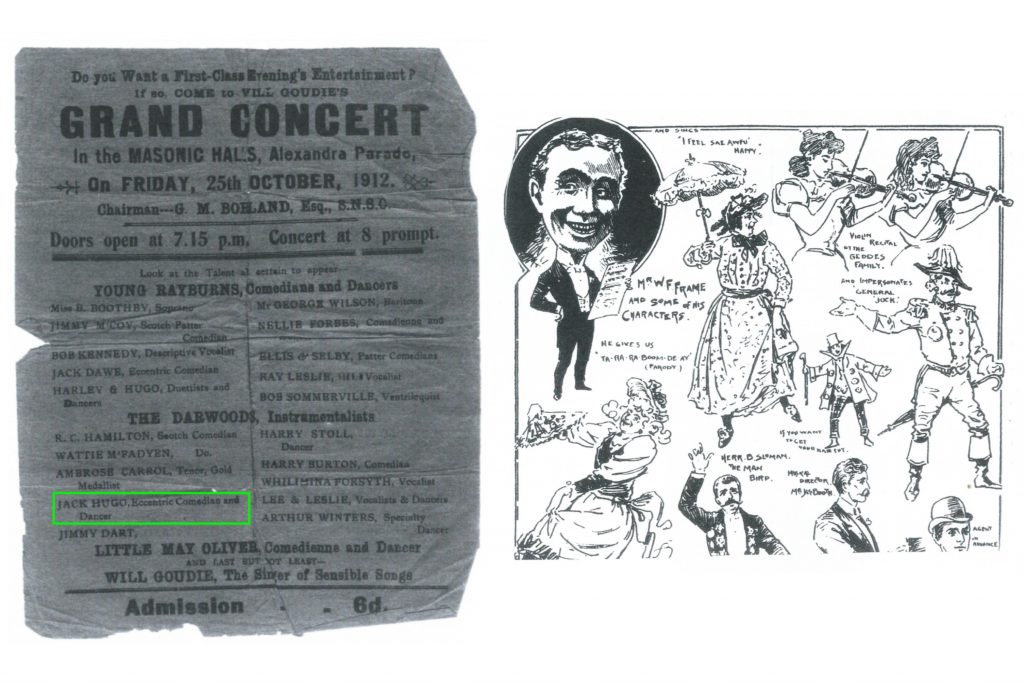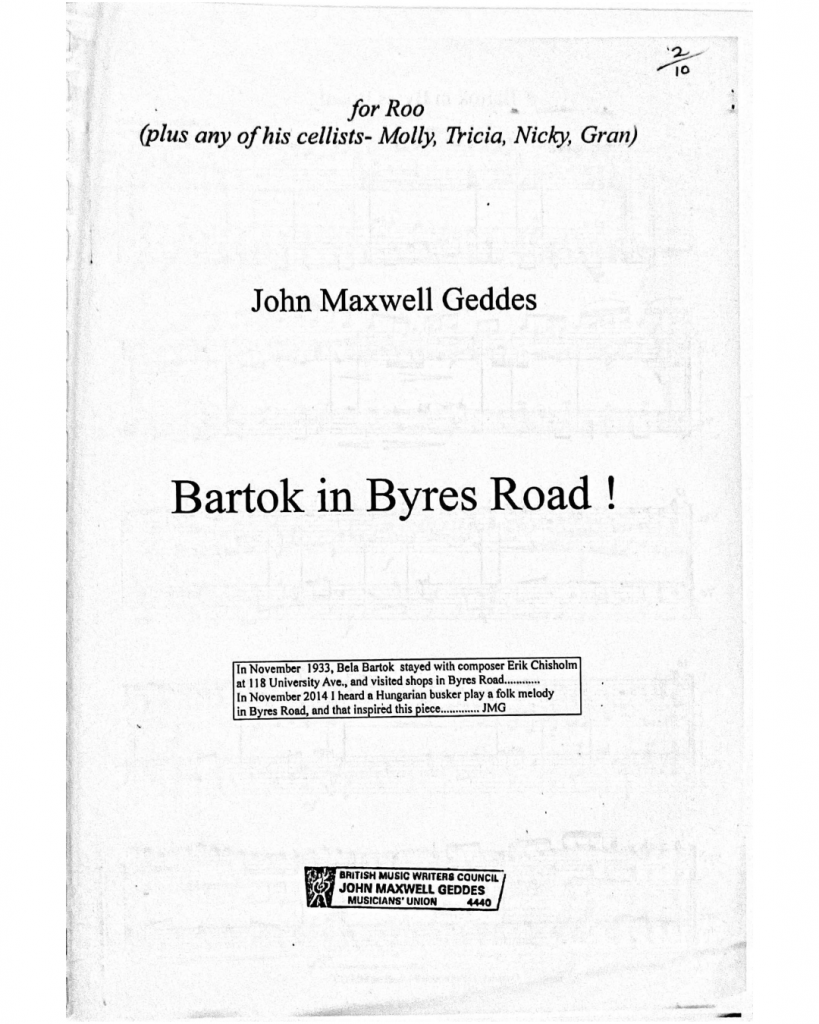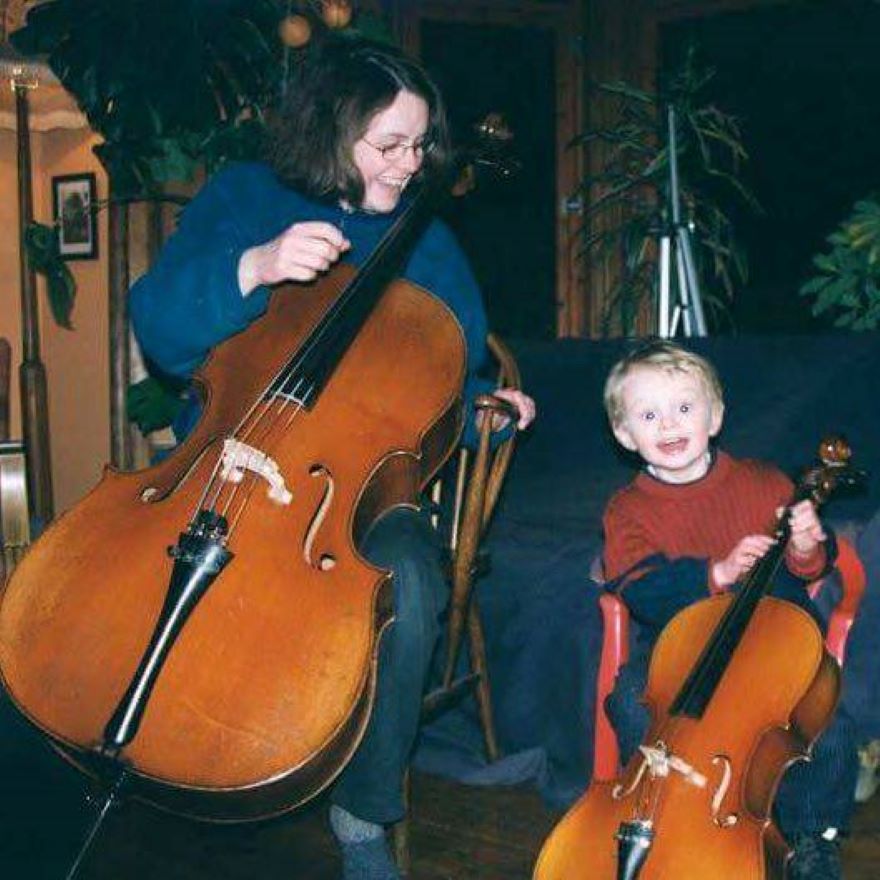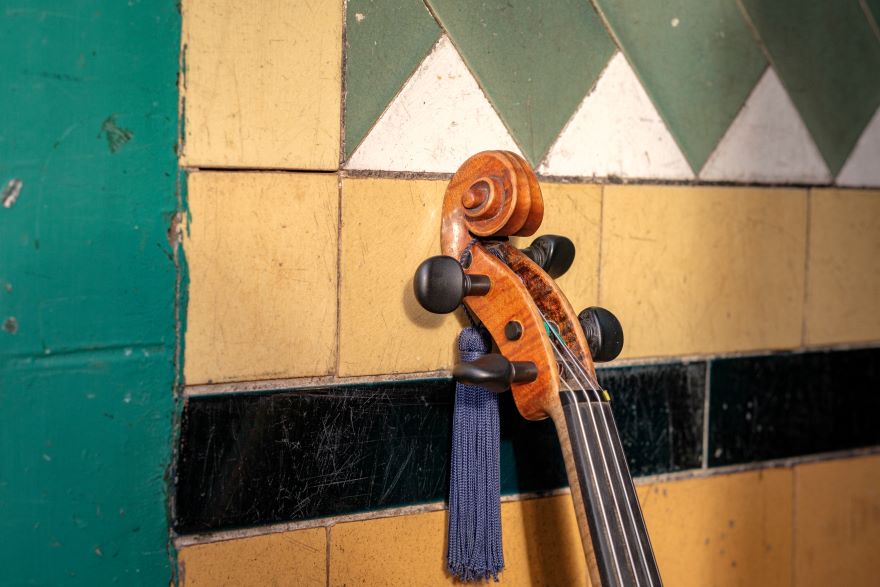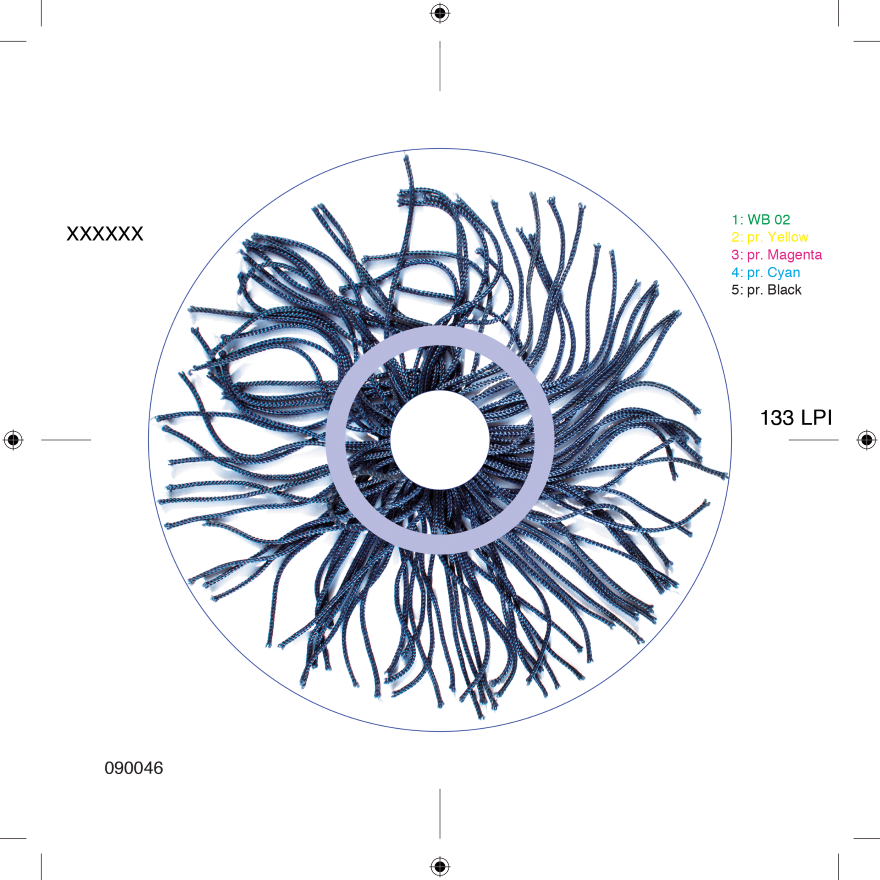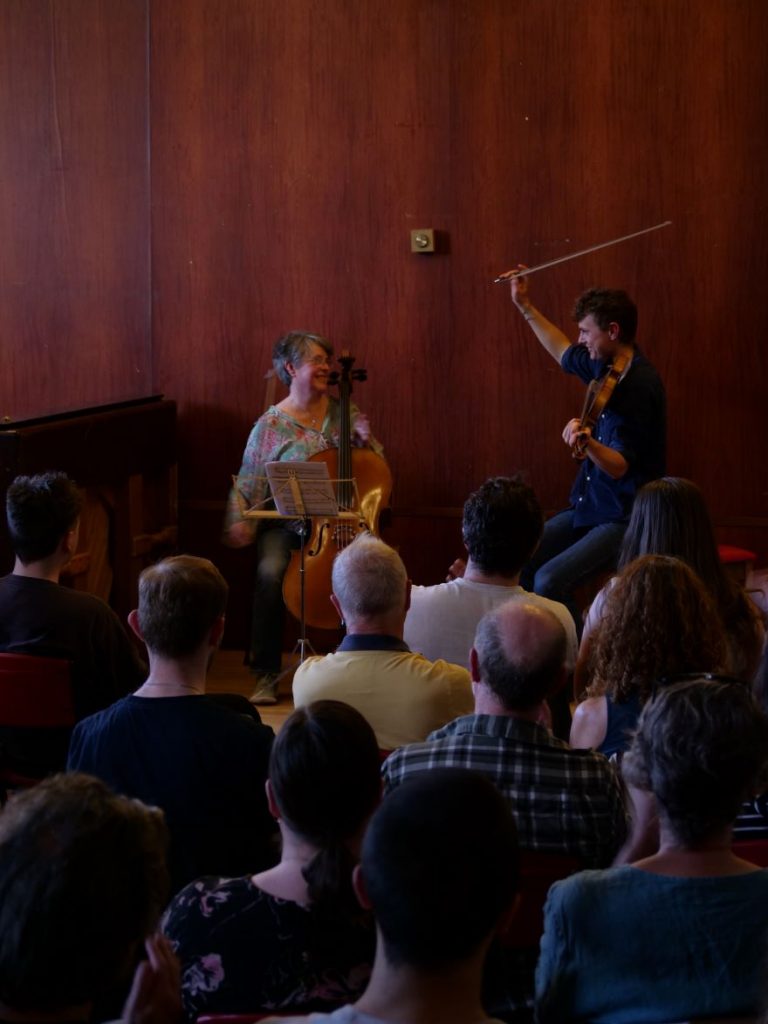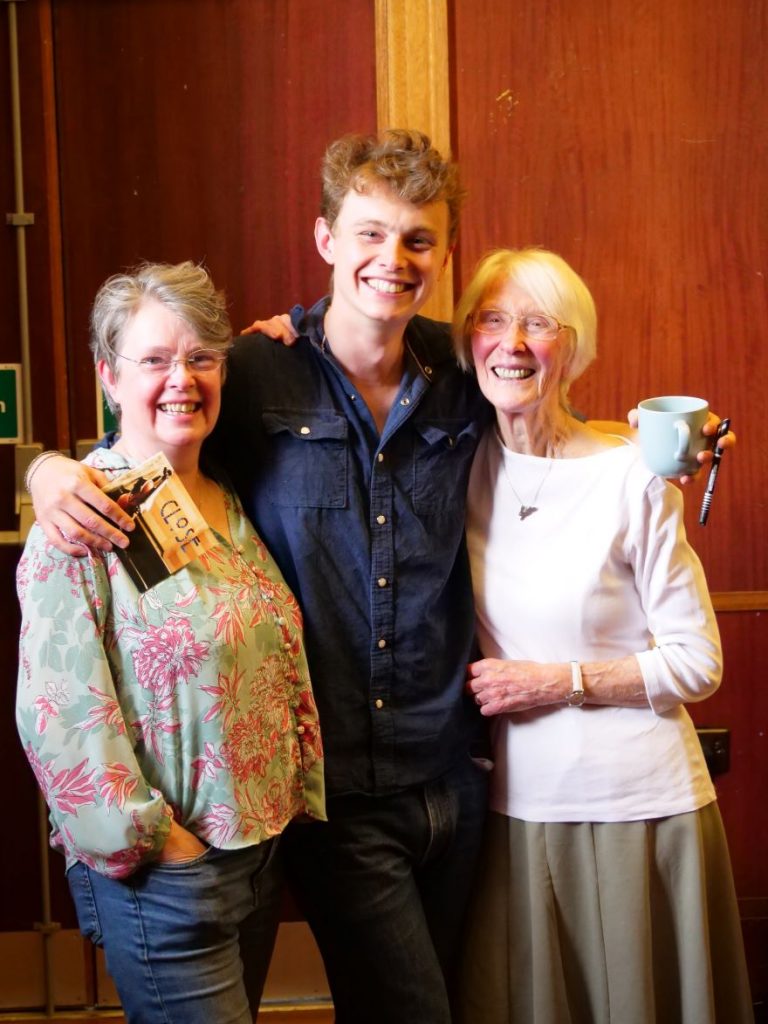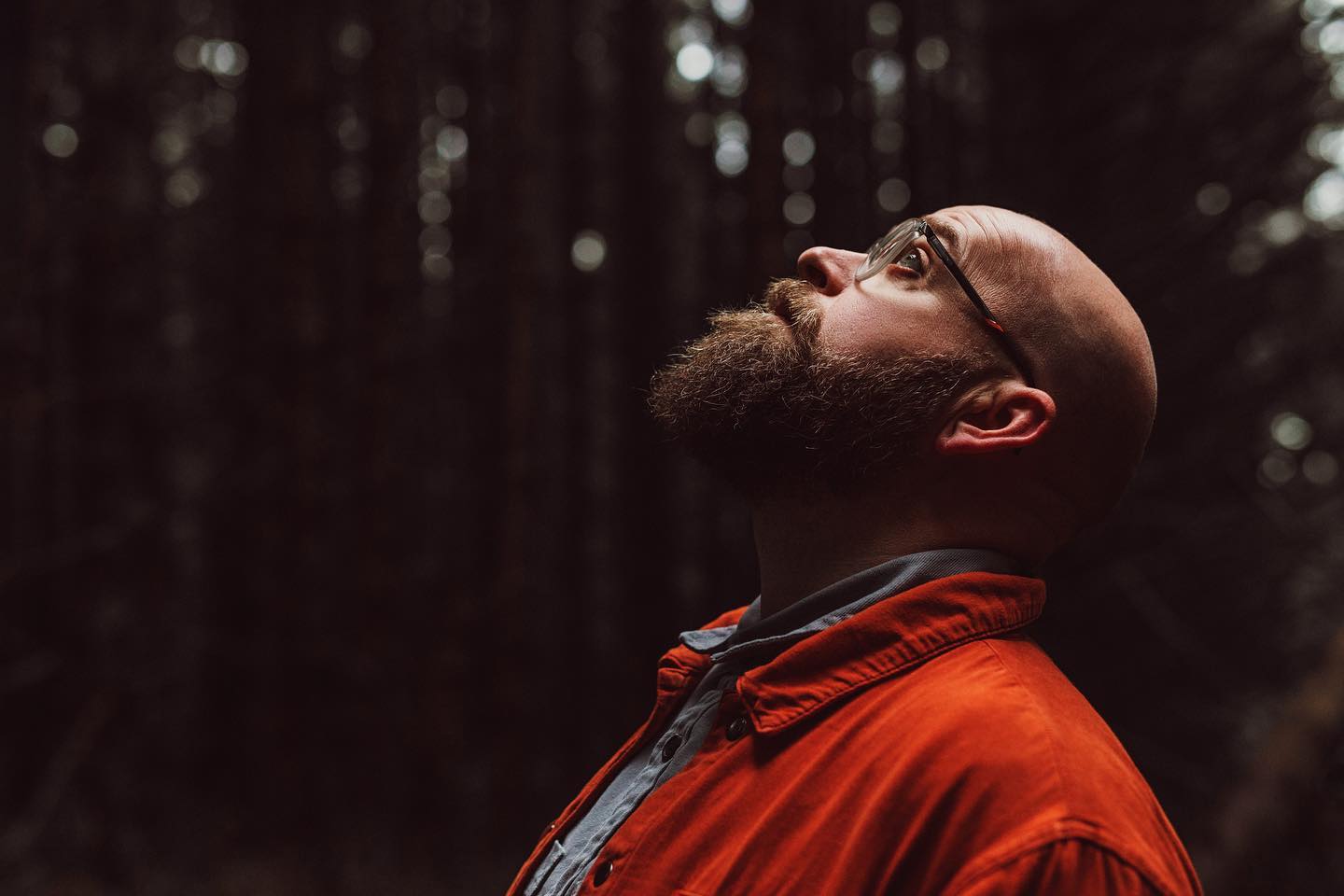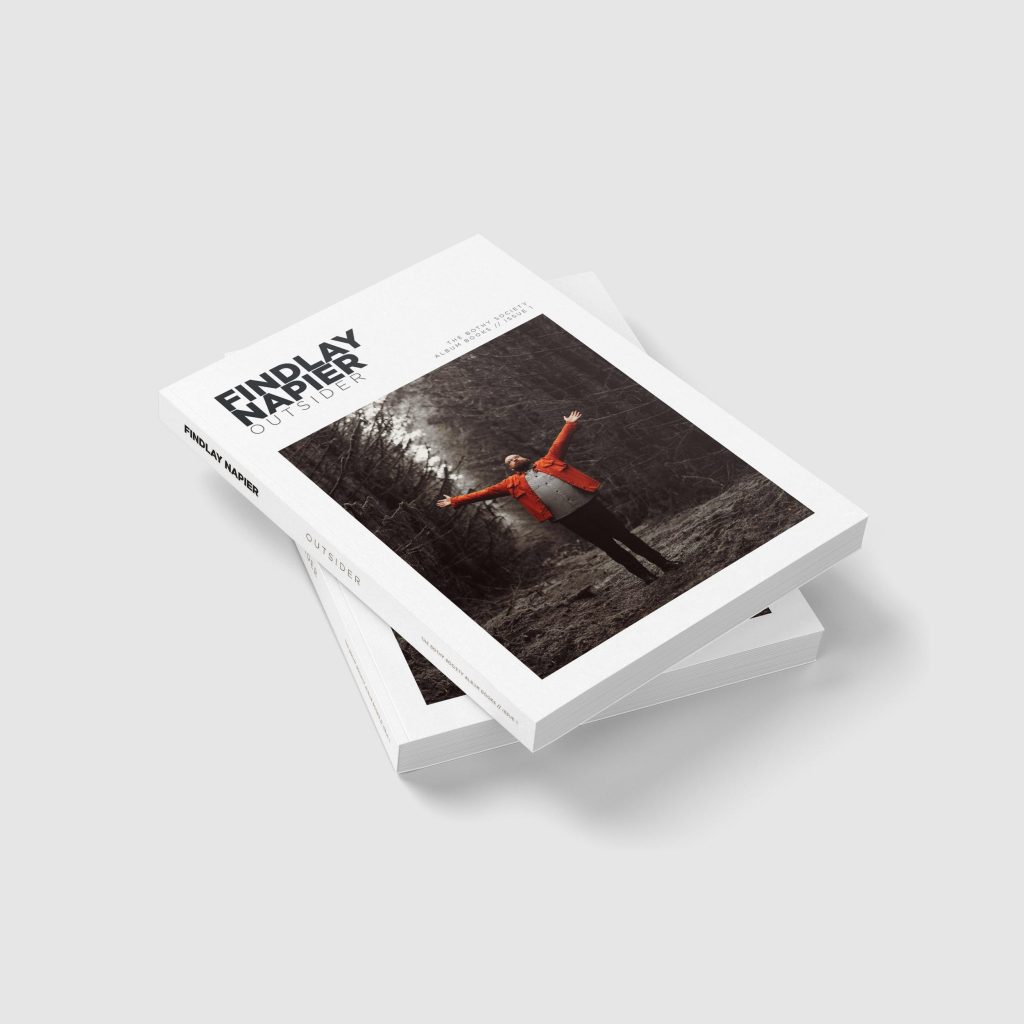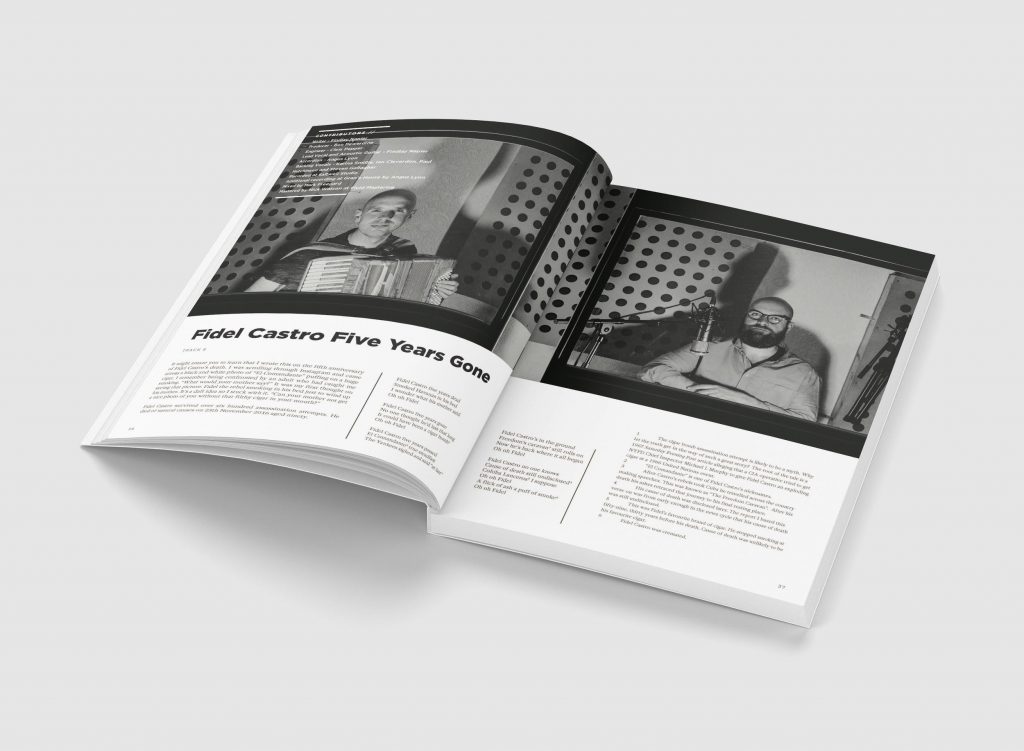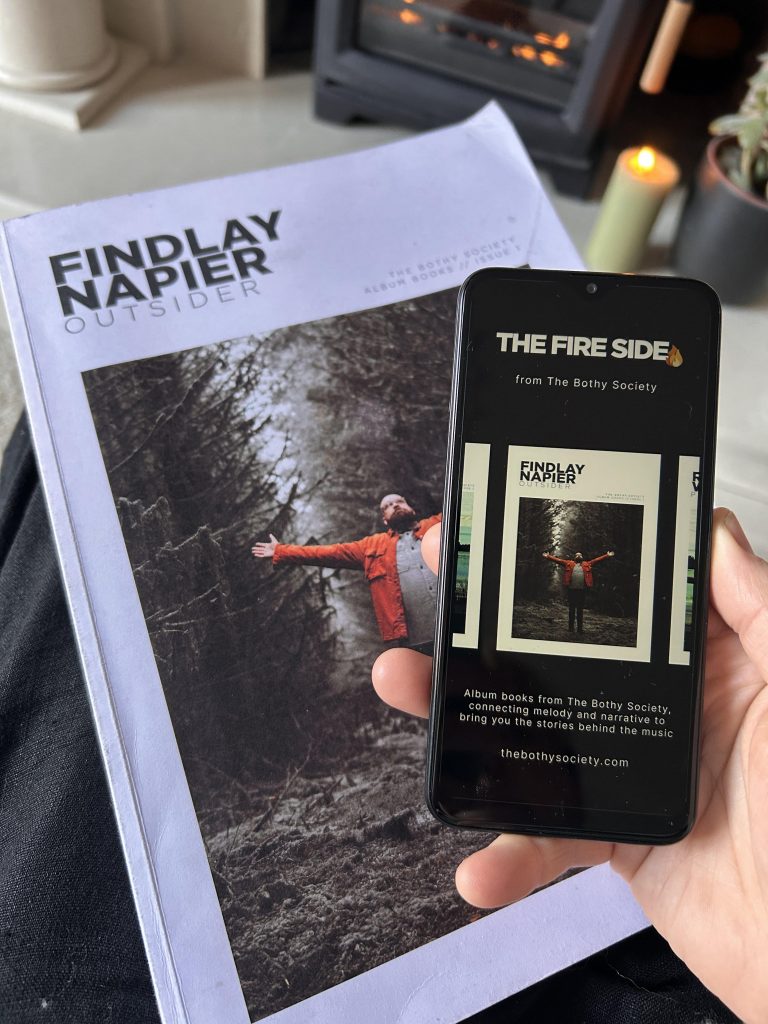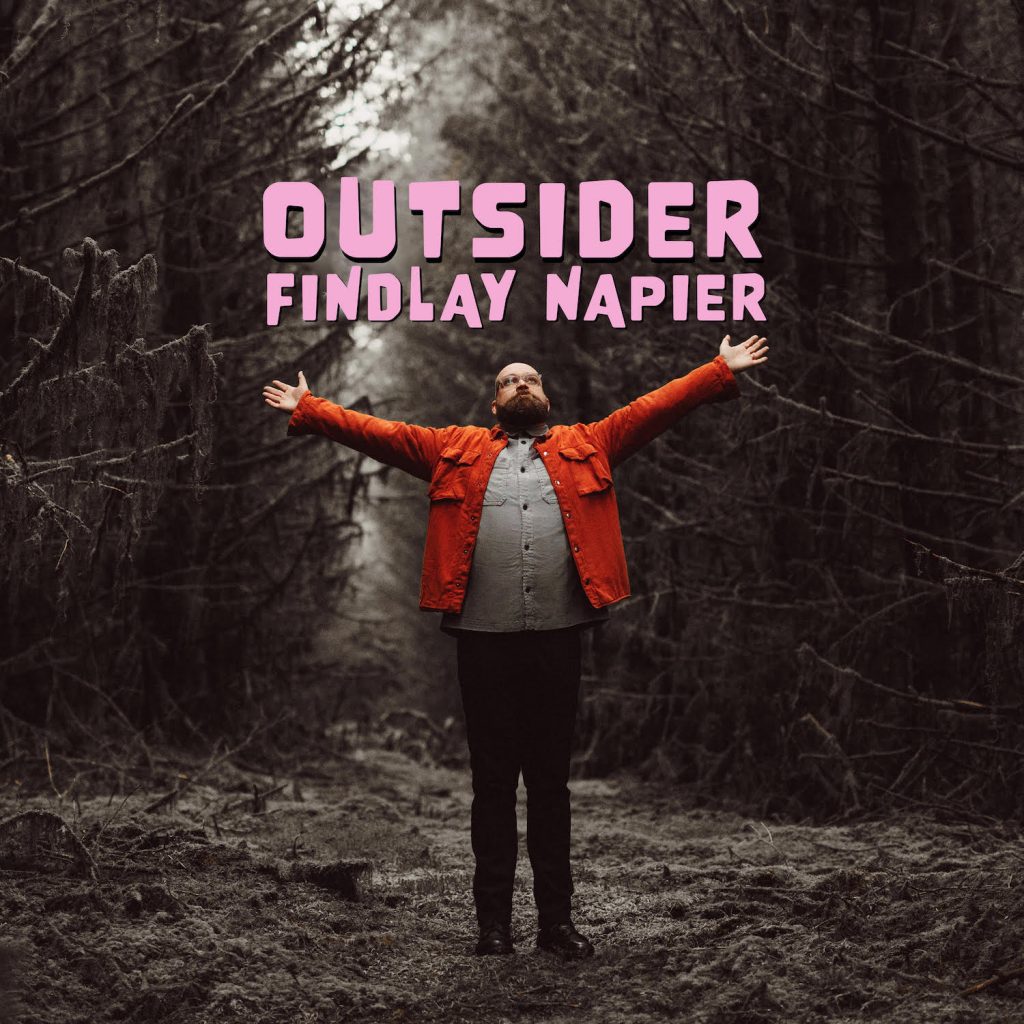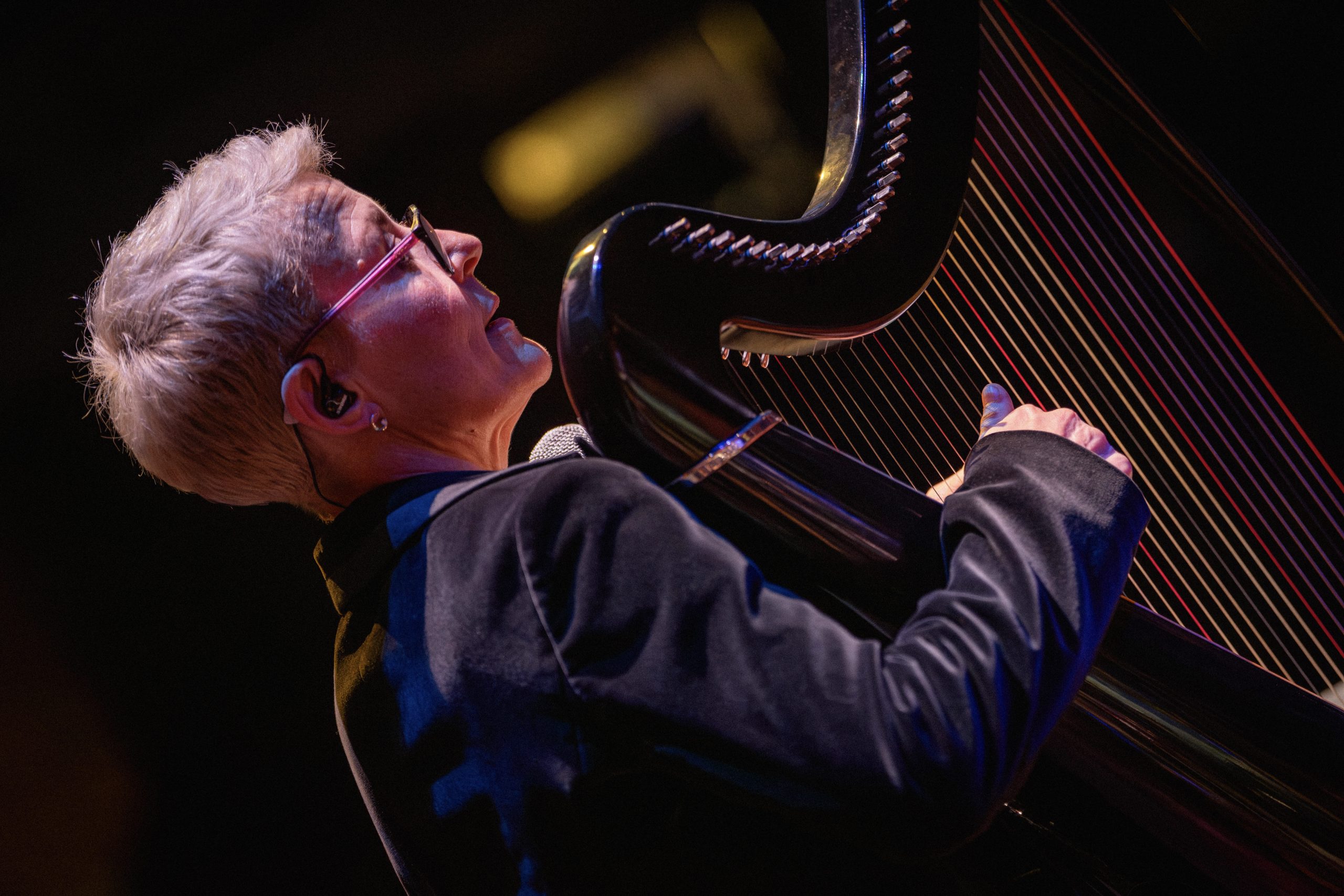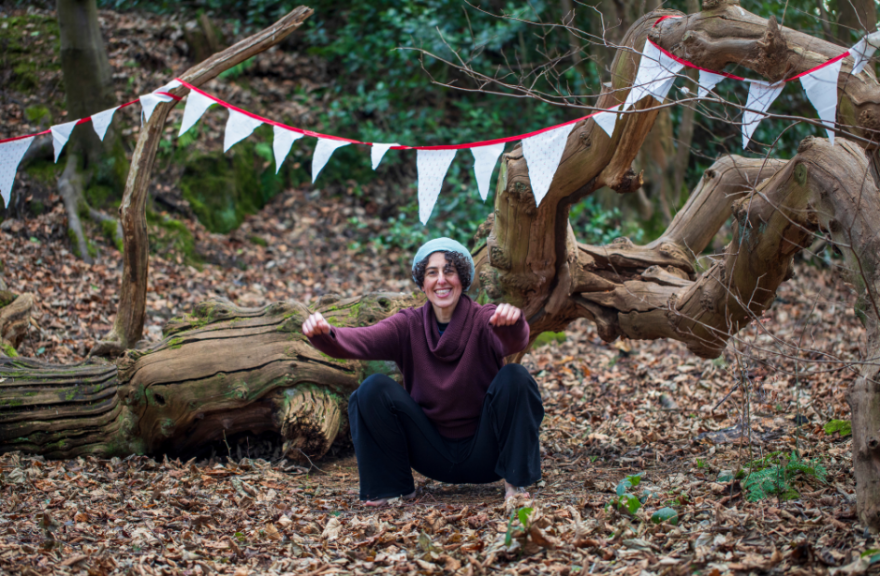I really love the strathspey, The Miller of Drone, and have been playing it a lot this past 6 months, getting to appreciate its personality and foibles. It is such a lyrical tune, and responds delightfully to either being driven hard, or gently coaxed. I got to wondering where the tune hailed from. Where is Drone (or Dron, as it is sometimes spelled)? Who was the miller? And does the tune have any link with the bawdy C18th song? And so began an excursion down a rabbit hole of old maps, books, photographs and recordings …… and a fair bit of chin scratching ….………
The Tune
First, to the tune. Here is a beautiful contemporary version by the talented duo Kevin Lees and Sebastian Bloch of The Good Tune.
Here is an old recording of The Miller of Drone briskly played by Anndra Reid from Canna, recorded by Dr John Lorne Campbell at some point during the period 1940-1960.
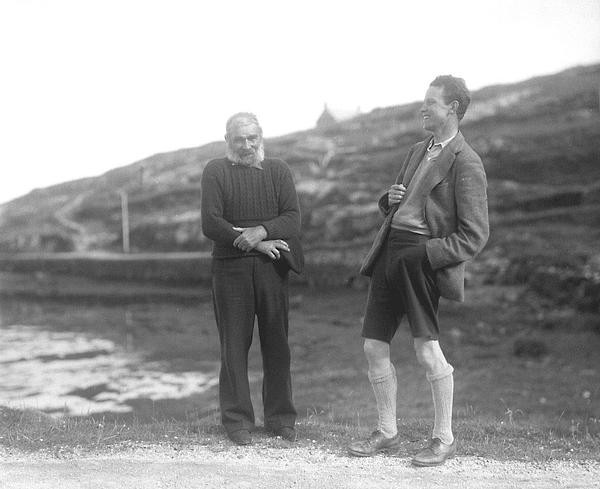
John Lorne Campbell on Canna
Image: Tobar and Dualchais
 The earliest published version of The Miller of Drone that I have been able to find is in John Pringle’s Collection of Reels, Strathspeys & Jigs (1801). Did he write the tune? In Anne Alburger’s 1983 book Scottish Fiddlers and their Music she points out that Pringle didn’t claim that he composed it – there are two other tunes on the same page which he identifies as his own, but not The Miller of Drone. Nathaniel Gow published the tune in his Gow’s Complete Repository (Part 2) in 1802, claiming that he composed it himself. It is even claimed sometimes that the tune was in fact written by Niel Gow – though I think this is unlikely as if it was the case, Nathaniel would have had to have claimed it as his own whilst his father was still alive – a snub I doubt he would have done.
The earliest published version of The Miller of Drone that I have been able to find is in John Pringle’s Collection of Reels, Strathspeys & Jigs (1801). Did he write the tune? In Anne Alburger’s 1983 book Scottish Fiddlers and their Music she points out that Pringle didn’t claim that he composed it – there are two other tunes on the same page which he identifies as his own, but not The Miller of Drone. Nathaniel Gow published the tune in his Gow’s Complete Repository (Part 2) in 1802, claiming that he composed it himself. It is even claimed sometimes that the tune was in fact written by Niel Gow – though I think this is unlikely as if it was the case, Nathaniel would have had to have claimed it as his own whilst his father was still alive – a snub I doubt he would have done.
John Pringle’s 1801 Collection
Image: Highland Music Trust
The traditional music publisher and collector John Glen (1833-1904) was well known for his strong opinions and his scepticism of the Gow’s compositional claims. He thought that it was unlikely that the strathspey had been written by either Niel or Nathaniel Gow. Time and ongoing research have softened the accepted views on the Gow’s claimed compositions, and have downplayed John Glen’s more extreme accusations of the Gow’s tune piracy. Although no-one can definitively identify the tune’s composer, personally I would tend to err on it being Nathaniel Gow.
Here is James Scott Skinner’s manuscript version of The Miller of Drone. He obviously held the tune in very high regard – so much so that when he published his own composition, The Miller o’ Hirn, he boasted that “‘The Miller o’ Drone’ will drone no more”. Whilst The Miller o’ Hirn is itself a fine strathspey, it would appear that The Miller of Drone more than held its own against its new rival — and still does.
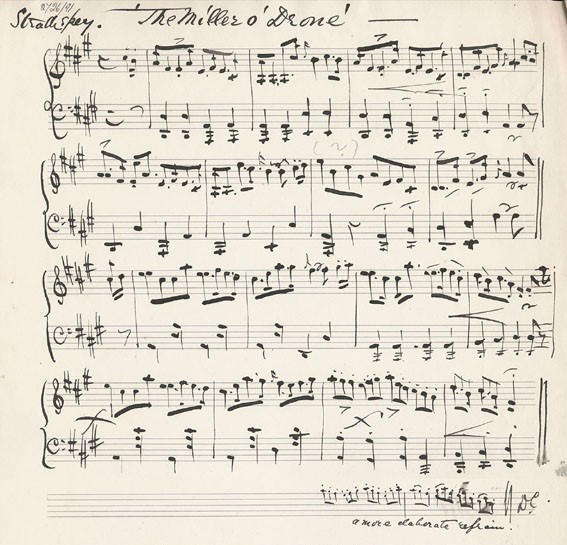
Image: James Scott Skinner Collection, University of Aberdeen
Another interesting aside is to note that in the C19th the Strathspey migrated to Ireland (as so many Scottish tunes have done) to become the reel, The First Month of Summer and the related tune The First Month of Spring. The First Month of Summer was first published by Francis O’Neill in his 1903 book Music of Ireland: 1,850 Melodies.

Music of Ireland: 1,850 Melodies, Francis O’Neill 1903; No. 1214, p. 229.
But there is also a much older tune called The Miller of Dron – a jig in the key of F, written down ca. 1741 by the Edinburgh fiddler and ‘Writing Master’ David Young in what is usually referred to as the ‘MacFarlane Manuscript’.

From: A Collection of Scotch Airs with the latest Variations. David Young ca. 1741
National Museum of Scotland Manuscript, NLS ms 2085. p,275
Where is Drone?
Being from Perthshire myself, and with Nathaniel Gow being the likely composer, I of course naturally assumed that it must be the Dron located in the hills on the north side of the Firth of Tay between Perth and Dundee. Stobie’s 1783 map of Perthshire shows Dron, and the adjacent Dron Hill (middle top of the below map).
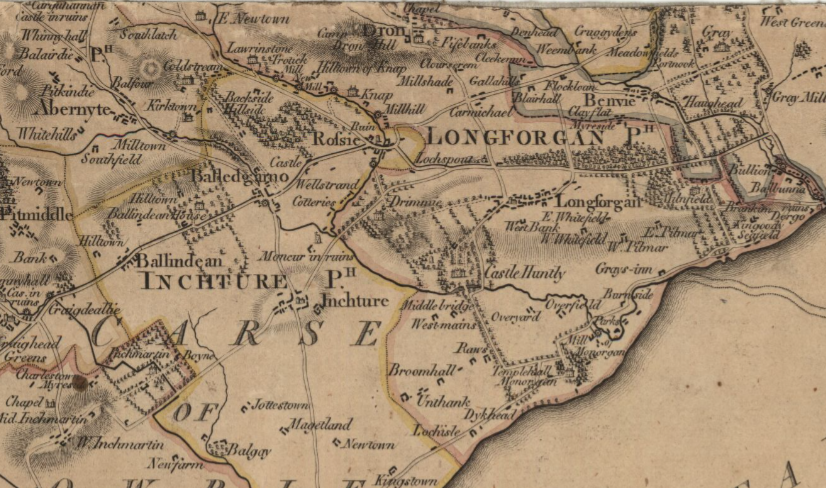
Stobie’s 1783 map of Perthshire
National Library of Scotland
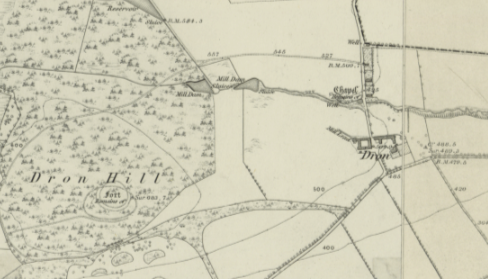 However, Stobie’s 1783 map doesn’t indicate that there was a mill there. The first Ordnance Survey map of 1867 shows by that time there was a mill. There are also no records that I could find showing the Perthshire Dron being spelled “Drone.” I began to get a hunch that this might not be the correct location and that I might have to look elsewhere.
However, Stobie’s 1783 map doesn’t indicate that there was a mill there. The first Ordnance Survey map of 1867 shows by that time there was a mill. There are also no records that I could find showing the Perthshire Dron being spelled “Drone.” I began to get a hunch that this might not be the correct location and that I might have to look elsewhere.
Ordnance Survey 6” to the mile map, 1867
National Library of Scotland
There is a Drone Hill in Coldingham, Berwickshire, and an Aberdeenshire version of the strathspey is titled “The Miller of Drum” potentially indicating that the mill might be in the north-east. However old maps show no mill in either location, so I discounted both these options.
Another avenue proved more promising. The current OS map shows that on the River Eden, close to Dairsie in north-east Fife, there was once a “Dron Mill.” The placename gets its first recorded mention in 1207 as “Drun” in a document setting out the villagers owing teinds of wheat to Leuchars kirk. A later judicial proceeding in 1484 shows a legal dispute involving the “Mill of Drone”. In the Blaeu Atlas of Scotland of 1654, James Gordon shows the place as “Drone Mill”. Subsequent maps show place names including Easter, Wester, North, South and Mickle Dron. Throughout the 15th to the 18th centuries the place name’s spelling alternated between Dron and Drone, settling eventually around 1800s to Dron. The last recorded use of the spelling “Drone” in maps / documents appears to be in an estate map drawn up sometime in the 1790s, showing “The Estate of Drone”.

Blaeu Atlas of Scotland, James Gordon, 1654
National Map Library of Scotland
Despite that there is no longer an extant mill building, there is documentary evidence of a mill being there from the 15th century onwards. I am therefore convinced that the location of the Dron/Drone mill of the tune is in Fife.
The Mill of Drone
According to Watermills on the River Eden by Anders Jespersen in the Journal of the Society of Antiquaries of Scotland (1966) ……..
Dron Mill was the smallest mill on the River Eden. It took water from the tail race of Lydox Mill, and contained — despite its limited dimensions – two pairs of stones, and a kiln, the lower part of which is cut out in the sandstone rock. The breastshot wheel was situated at the gable, which was built in ashlar stone-work, terminating in a string course just over the wheel, and above this rubble stone-work. The mill was shown on the 1645 (Blaeu) map.
The 1862 OS map shows that Dron Mill was obviously working then as a corn mill. However, by the time of the survey for the second edition of the OS 6”to-the-mile map in 1893, Dron Mill is shown as being without a roof, and therefore no longer in operation.

OS 6” to the Mile map, 1862
National Map Library of Scotland
The Song
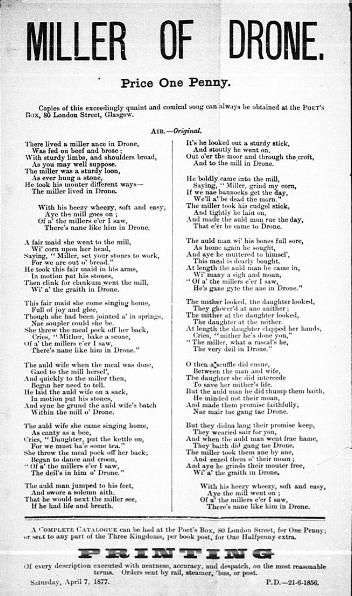 The next tunnel down the rabbit hole leads us to the bawdy C19th song, The Miller of Drone.
The next tunnel down the rabbit hole leads us to the bawdy C19th song, The Miller of Drone.
There lived a miller ance in Drone,
Was fed on beef and brose:
With sturdy limbs, and shoulders broad,
As you may well suppose.
The miller was a sturdy loon,
As ever hung a stone.
He took his mouter different ways,
The Miller lived in drone.
Mouter is a Scots word referring to the payment (often in kind, such as with meal or grain) that a tenant was legally obliged to give to a mill. The song goes on to detail the shenanigans of a daughter and her mother when they take their corn to the mill to be ground, and the obliging Miller who “in motion put his stones.” It would appear that their visits were frequent, and that no money was exchanged for the miller’s various services.
The Miller of Drone, printed by Poet’s Box, 80 London St., Glasgow. (7th April 1877)
Image: Vaughan Williams Memorial Library
When was the song The Miller of Drone written?
The earliest published version of the song that I have come across is the chapbook broadsheet, The Jolly Miller of Drone, printed in Falkirk in 1813.
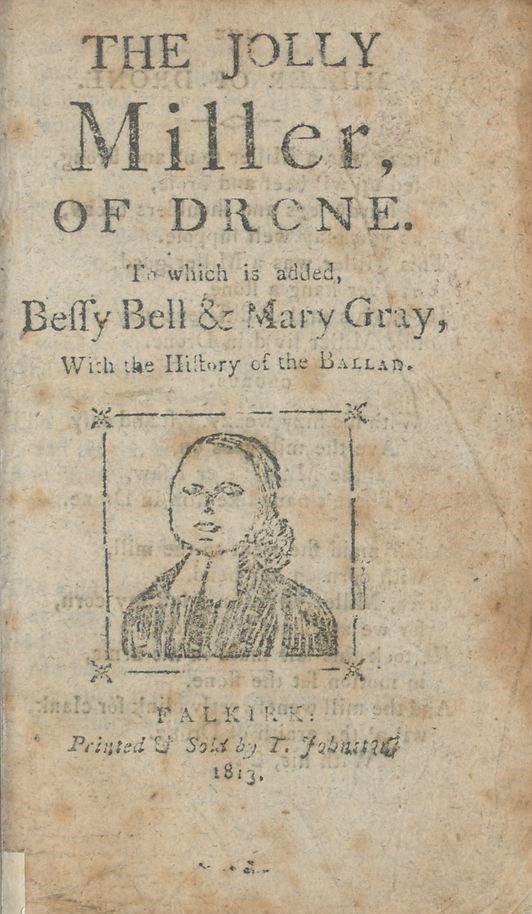
The Jolly Miller of Drone, Falkirk 1813
National Library of Scotland
Can we turn to fine art to give us a clue as to when the song was written? The East Lothian born, Edinburgh-based painter Alexander Carse (c. 1770 – 1843) painted an oil canvas, “The Miller of Drone” around 1820. It shows a scene in an alehouse with the miller regaling all around him and obviously thoroughly enjoying both the beer and the attentions of the barmaid. Alexander Carse mostly spent his days in and around Edinburgh where he mainly painted scenes of village and rural life: a barber’s shop, a brawl outside an alehouse, (rowdy) village ball games, penny weddings etc. Were these paintings done in situ? Or were the buildings and backgrounds quickly sketched in a suitable location, with the characters and detail painted afterwards in his studio? I suspect the latter – and that his paintings were mostly created from his imagination: I doubt if he went to Drone in Fife to find the authentic local alehouse and its inebriated miller. It is also safe to assume that the song must have been known and presumably widely sung throughout lowland Scotland when he painted the scene around 1820. This is confirmed by an 1871 Banffshire journal entry which states that the song was very popular in the local area around 1820. It is impossible to give a definitive answer as to when the song was written, but my hunch is that it dates from the C18th.
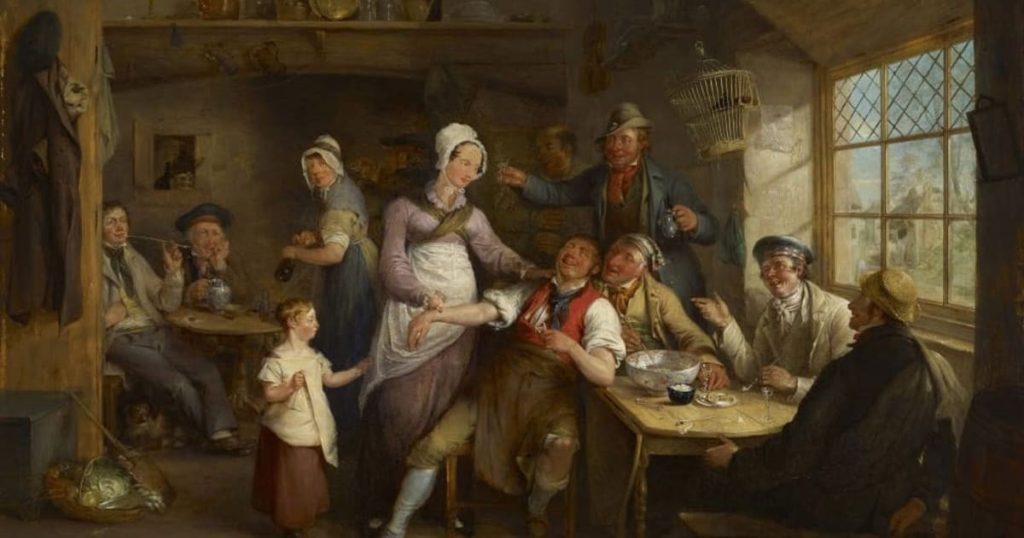
The Miller of Drone, by Alexander Carse.
Usage: Creative Commons
Is there a link between the strathspey and the song?
Was the song sung to the strathspey tune? Or are the two entirely separate? Is there a link between the song and the similarly titled C18th jig?
The 1877 Greig-Duncan collection Folk Song of the North East (Volume 7) gives three versions of the song. The accompanying tune given is the popular Aberdeenshire song “The Battle of Harlaw” and not the Gow Strathspey. It is possible that the use of this tune is purely local to the Aberdeenshire area – people may have preferred to use a better-known local melody, rather than the more southerly strathspey.
There is a recording made by Alan Lomax in 1951 of William Mathieson of Turriff singing a snippet of The Miller of Drone. The singing is somewhat wavering and it’s difficult to make out the tune. However, I don’t think that the melody is either The Battle of Harlaw, the C18th jig, or Nathaniel Gow’s strathspey.
The clip can be found in the Lomax Digital Archive.
So far, I’ve not found the song melody noted in any other folk song collections. It is possible that the song melody used was the similarly titled strathspey. However, whilst the verse fits beautifully into the A part of the Strathspey, the shorter chorus is only half the of the Strathspey’s B past. Of course, you could simply repeat the same 4 lines of the chorus to make it fit. Or of course it is quite possible that the song has absolutely nothing to do with the strathspey, and that Nathaniel Gow simply wrote the tune to jump on the bandwagon of an already popular song. Can anyone throw some more light on the matter?
And finally……..
Looking back through time, each generation changes its interpretation and understanding of all matters historical. Given that we can never have all the facts (and anyway, one person’s “fact” is only their interpretation of “the truth”), it is a rash person who would state definitively that they alone have THE answer. So, here I have put forward a theory or two on the origins of The Miller of Drone. No doubt someone with access to more / other information will put forward a different / more convincing theory: such is the shifting sands of writing about anything historical! Whoever and whenever that happens, I look forward to hearing from them.
———-
Munro Gauld is a freelance traditional musician, ethno-musicologist and musical historian
Email: [email protected]



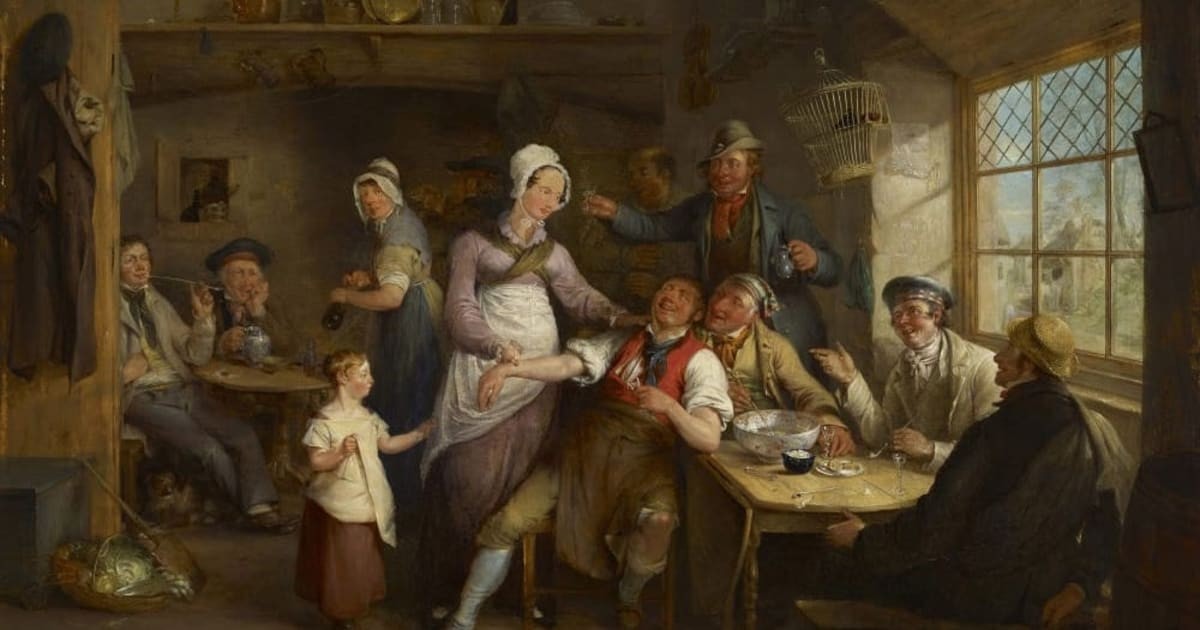

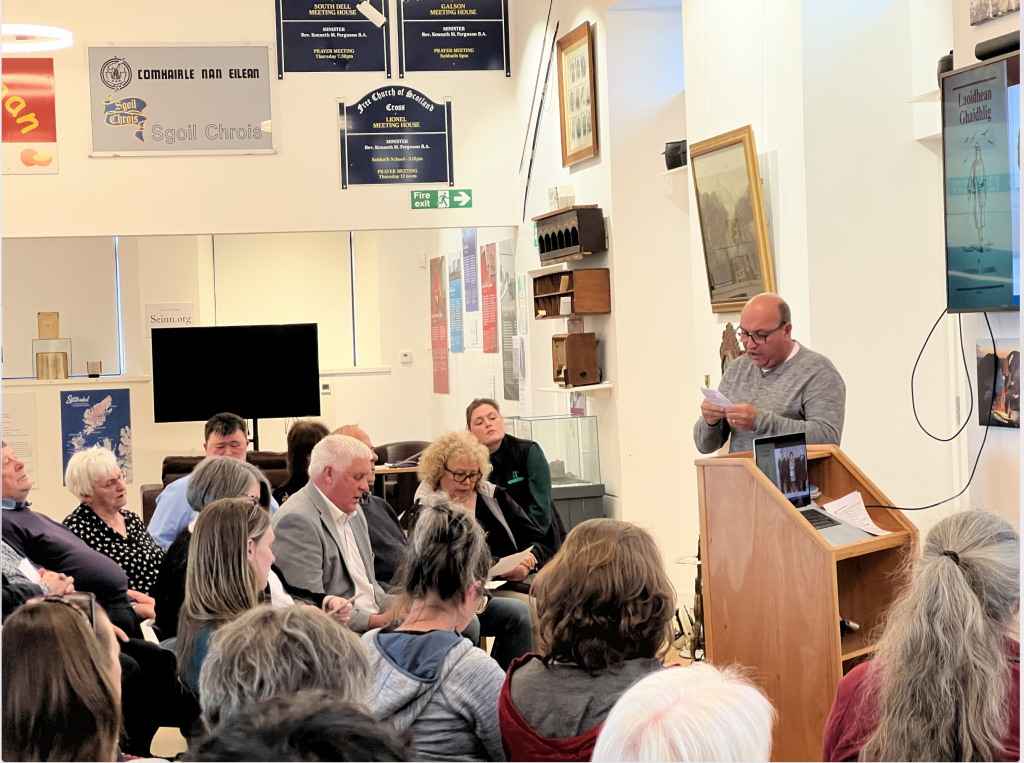 📷 Angus Murray singing at a public talk, Comunn Eachdraidh Nis, Ness, Lewis. June 2025. (Photo by Mary Stratman)
📷 Angus Murray singing at a public talk, Comunn Eachdraidh Nis, Ness, Lewis. June 2025. (Photo by Mary Stratman)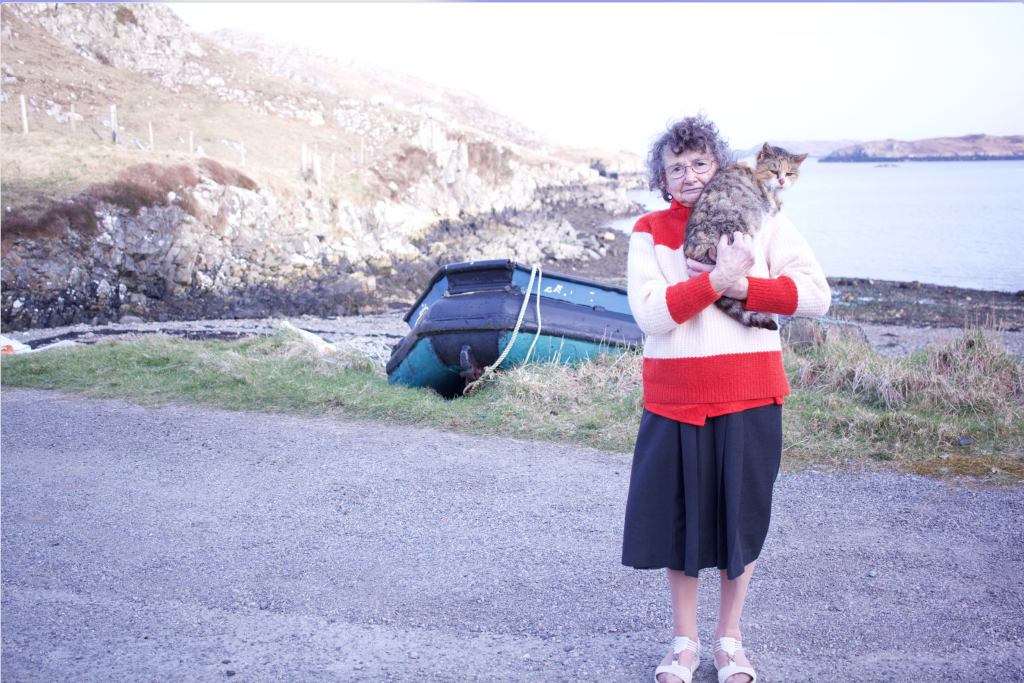 📷 Marybelle MacKinnon, Crossbost, Lewis. March 2022. (Photo by Frances Wilkins)
📷 Marybelle MacKinnon, Crossbost, Lewis. March 2022. (Photo by Frances Wilkins)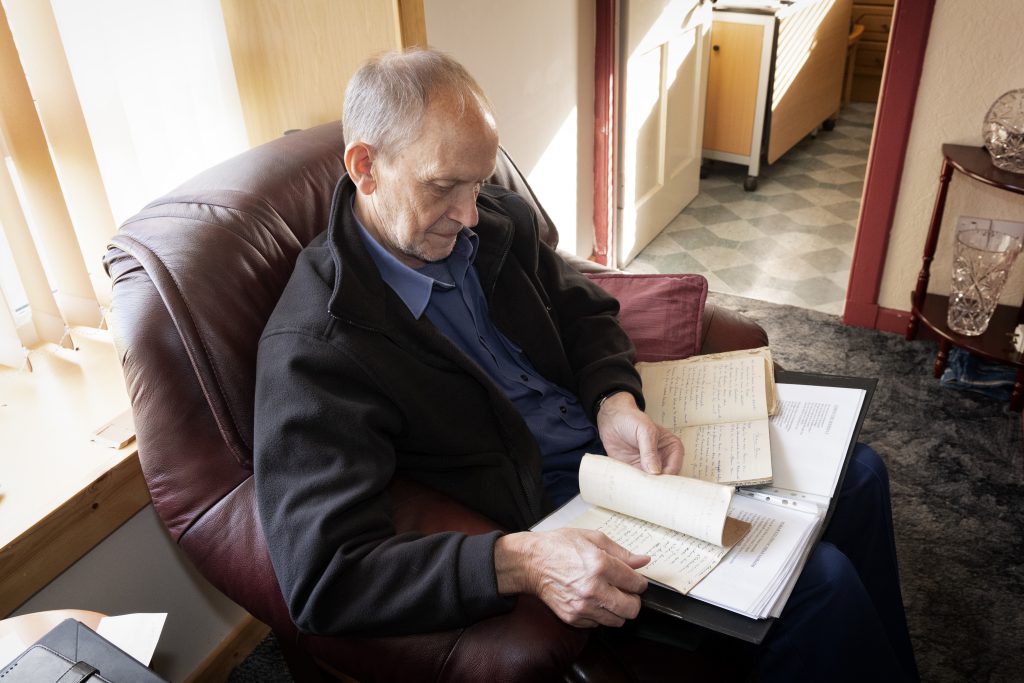 📷 Murdo J Morrison, bard and Gaelic psalm precentor, Fivepenny, Ness, Lewis, March 2022. (Photo by Mairi M Martin)
📷 Murdo J Morrison, bard and Gaelic psalm precentor, Fivepenny, Ness, Lewis, March 2022. (Photo by Mairi M Martin)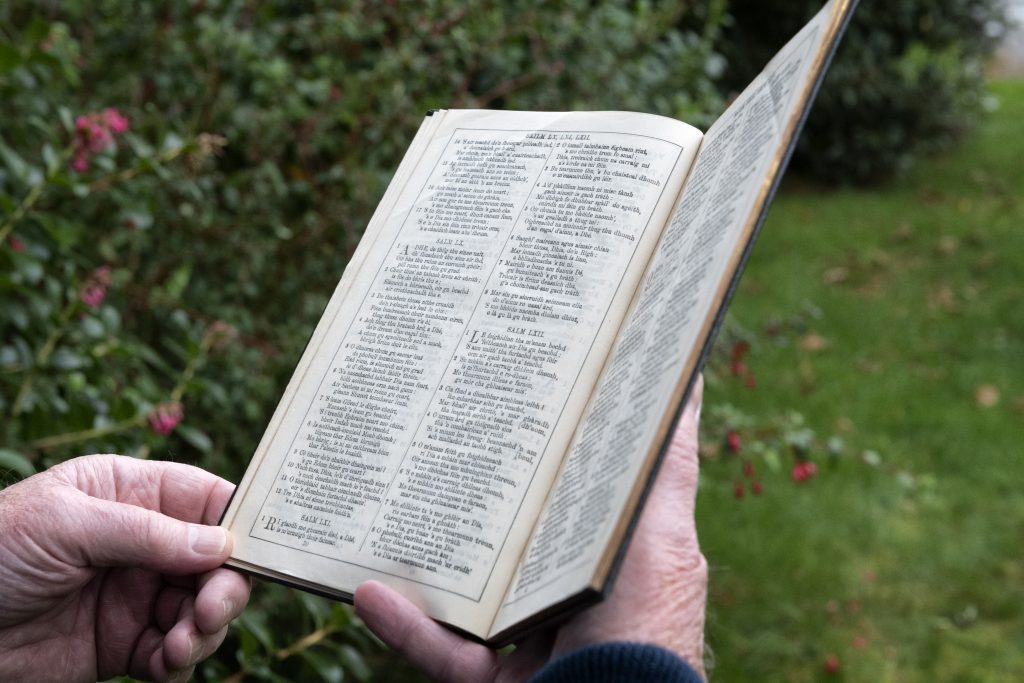 📷 Gaelic psalter. (Photo by Mairi M Martin)
📷 Gaelic psalter. (Photo by Mairi M Martin)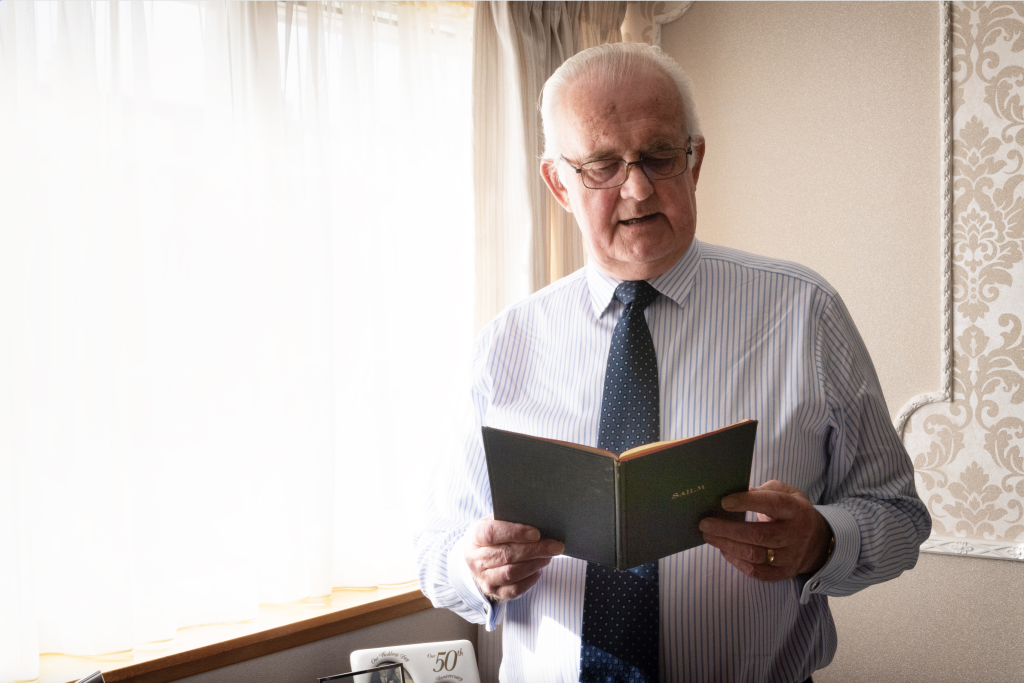 📷 D R MacDonald, Gaelic psalm precentor, Stornoway. October 2022. (Photo by Mairi M Martin)
📷 D R MacDonald, Gaelic psalm precentor, Stornoway. October 2022. (Photo by Mairi M Martin)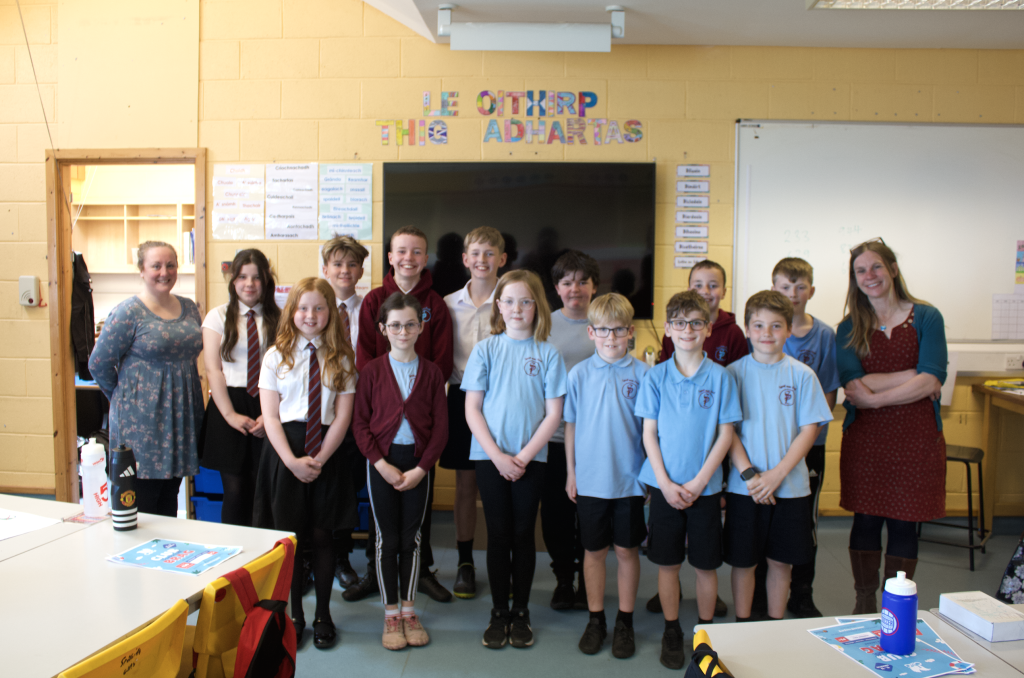 📷 Children from Sgoil nan Loch who sang a Gaelic psalm at the Stornoway Mòd, winning first place. With Gemma Malcolm, Kinloch Historical Society. June 2025. (Photo by Mary Stratman)
📷 Children from Sgoil nan Loch who sang a Gaelic psalm at the Stornoway Mòd, winning first place. With Gemma Malcolm, Kinloch Historical Society. June 2025. (Photo by Mary Stratman) 📷 Frances Wilkins with Hamish Taylor, Leverburgh, Harris. June 2025. (Photo by Mary Stratman)
📷 Frances Wilkins with Hamish Taylor, Leverburgh, Harris. June 2025. (Photo by Mary Stratman)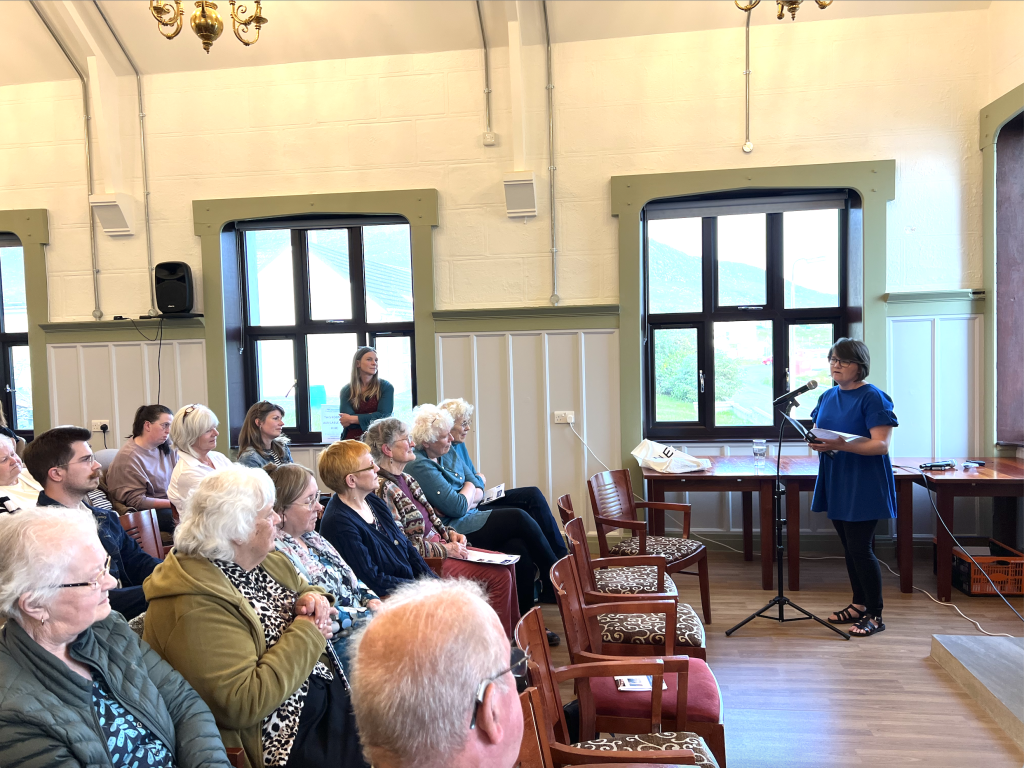 📷 Jeanna Cumming singing at public talk, Leverburgh, Harris. June 2025. (Photo by Mary Stratman)
📷 Jeanna Cumming singing at public talk, Leverburgh, Harris. June 2025. (Photo by Mary Stratman)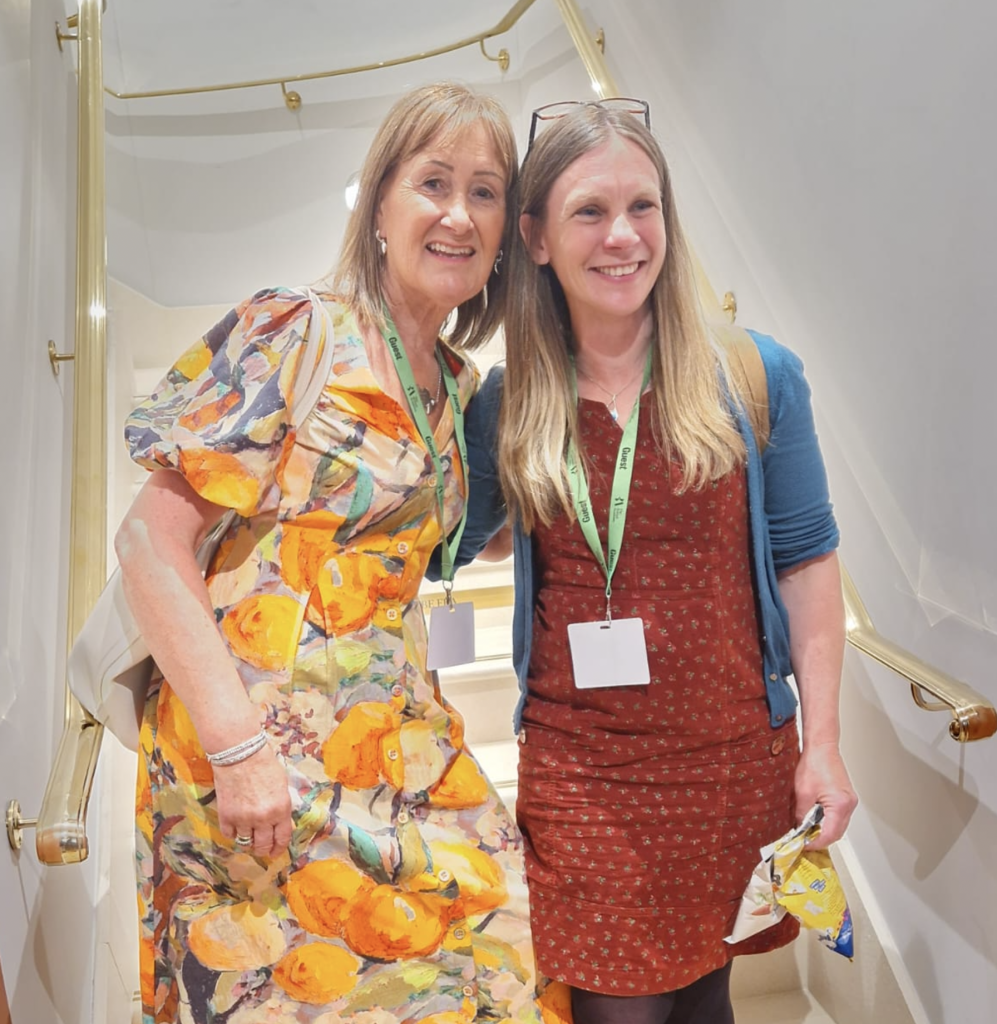 📷 Frances Wilkins and Kristine Kennedy at the British Academy, London. May 2025. (Photo by Oliver Wilkins)
📷 Frances Wilkins and Kristine Kennedy at the British Academy, London. May 2025. (Photo by Oliver Wilkins)
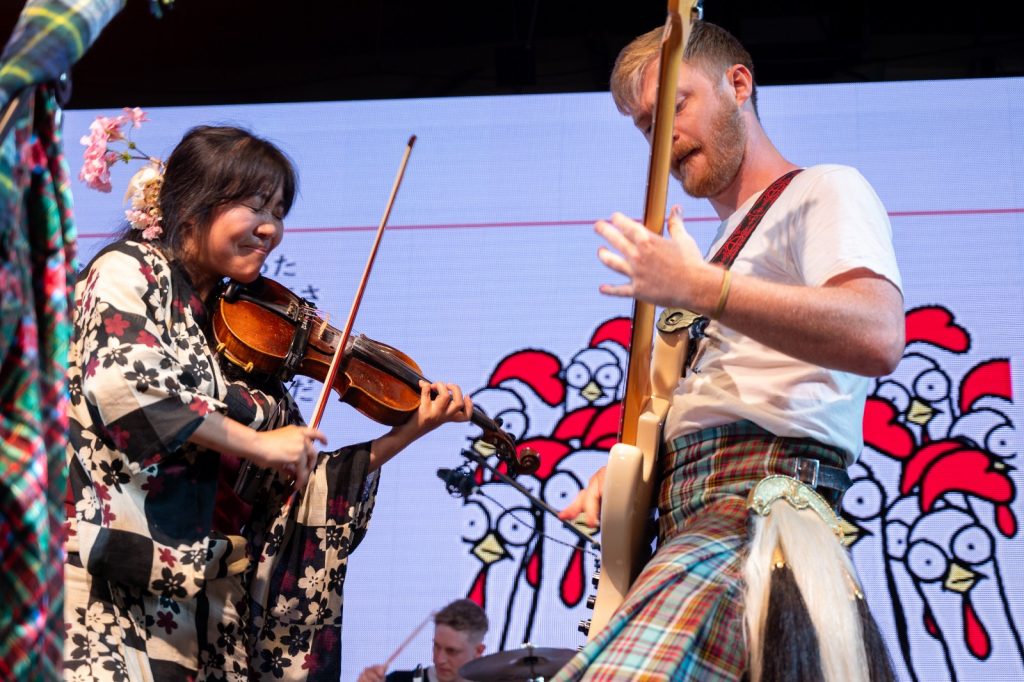

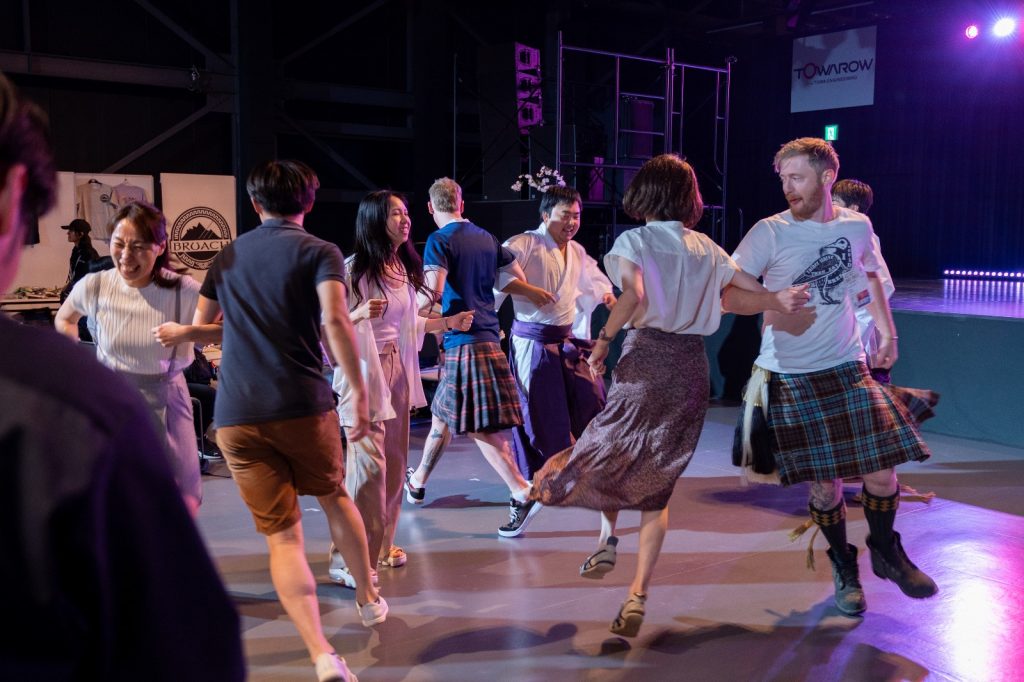
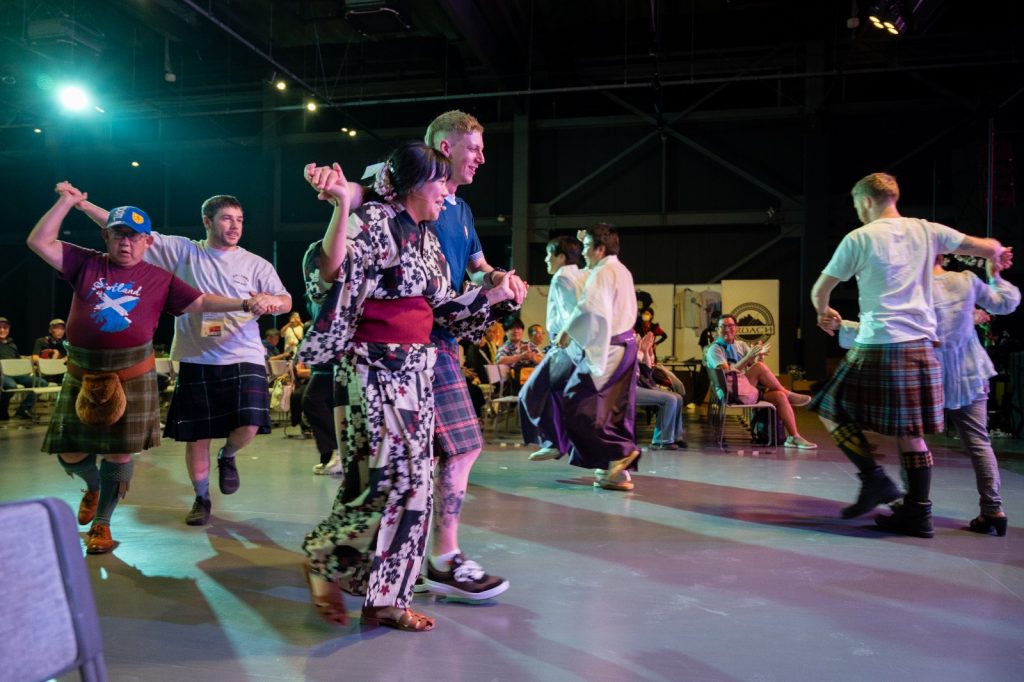
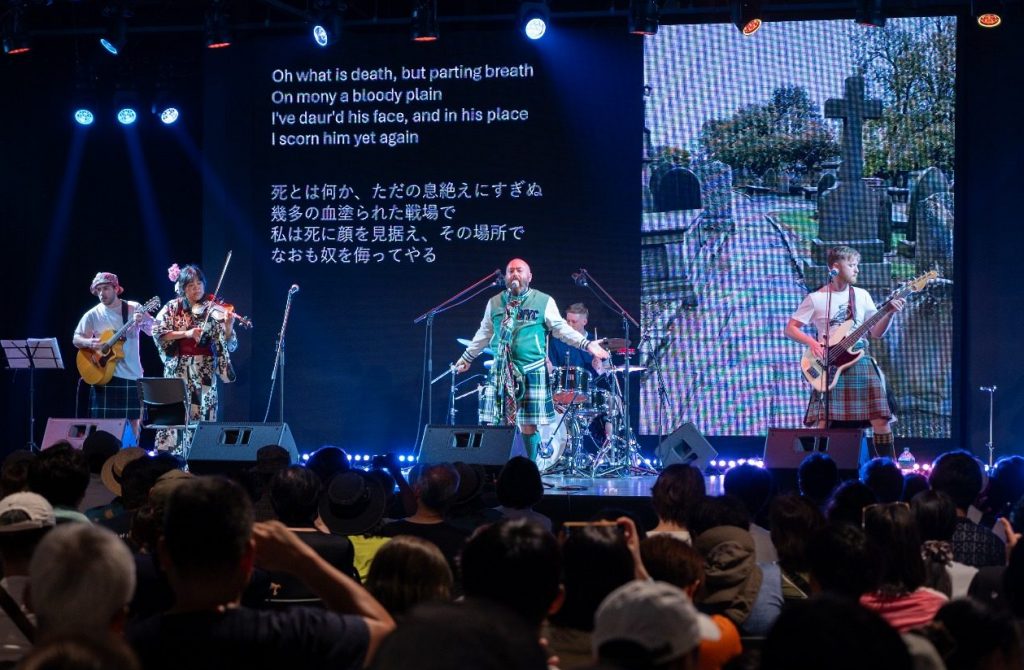
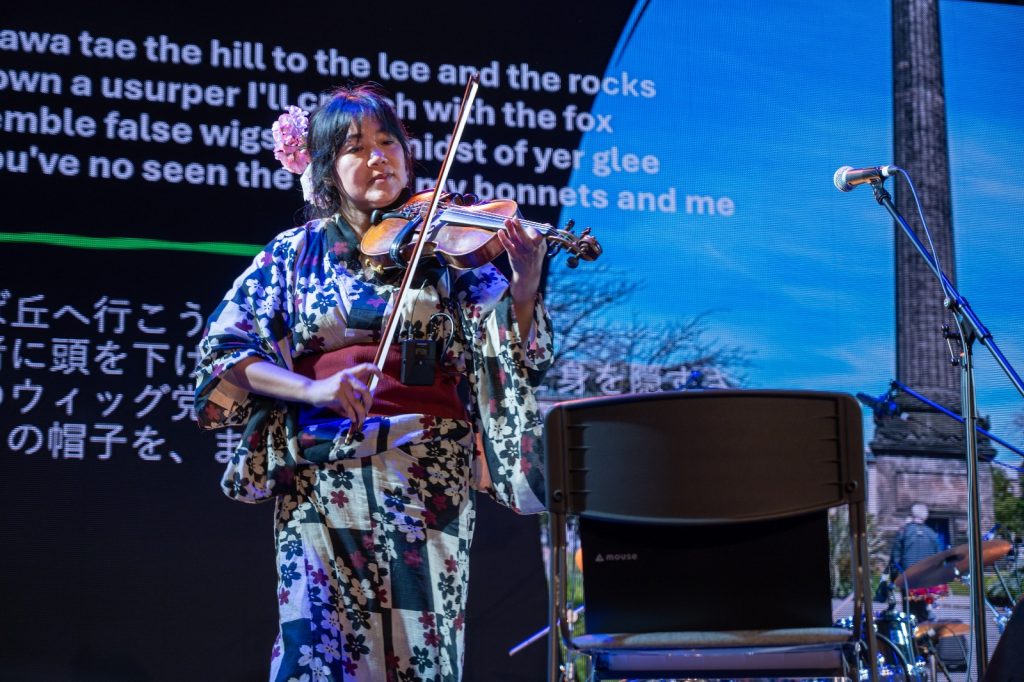
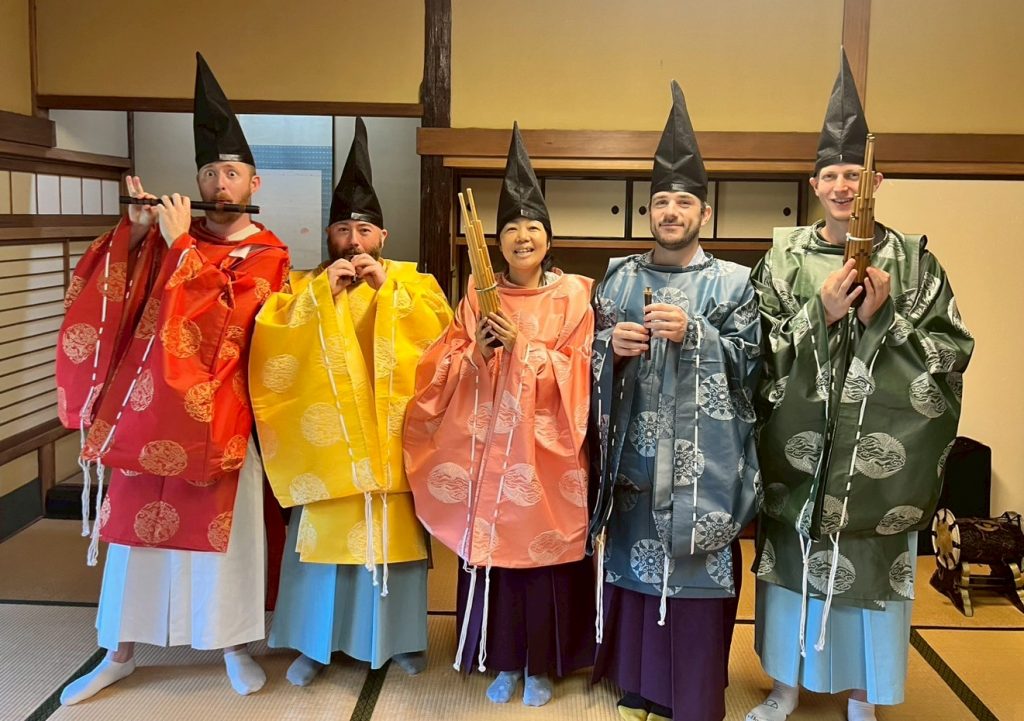
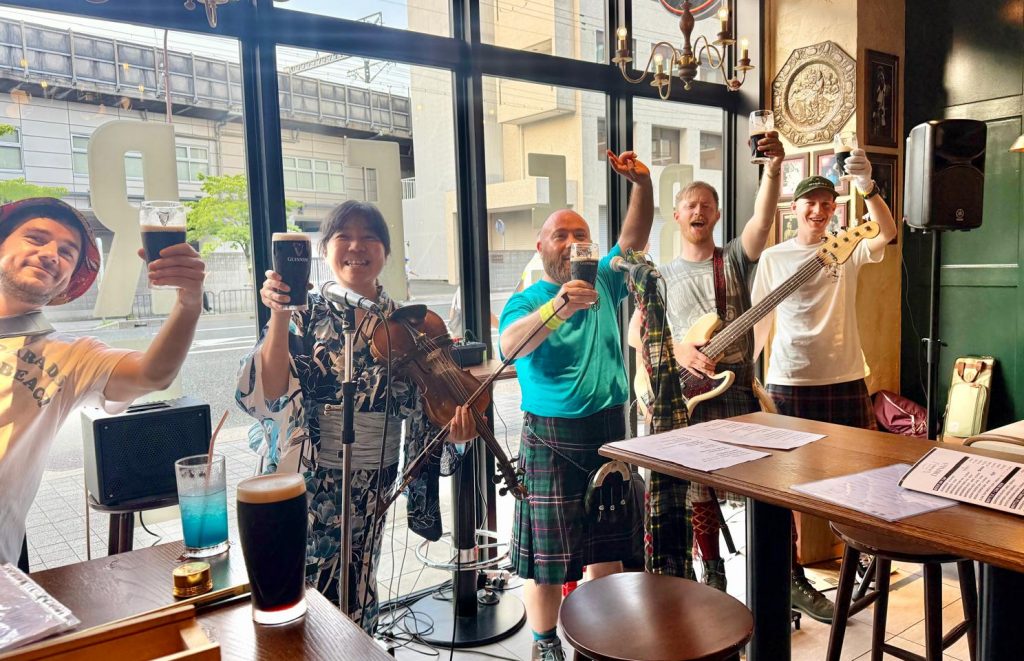
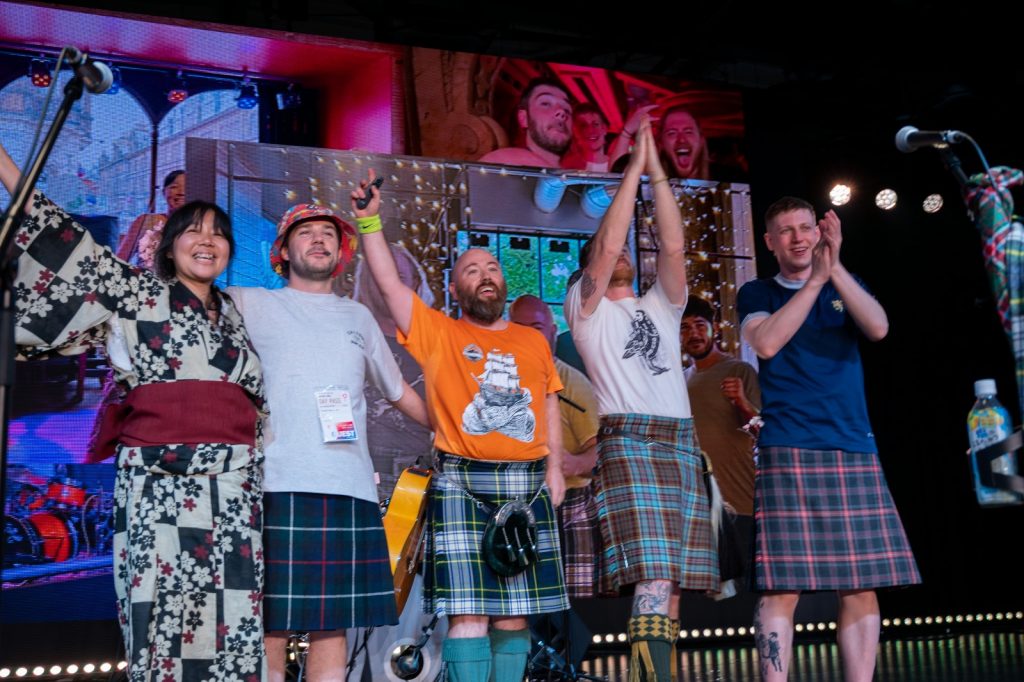
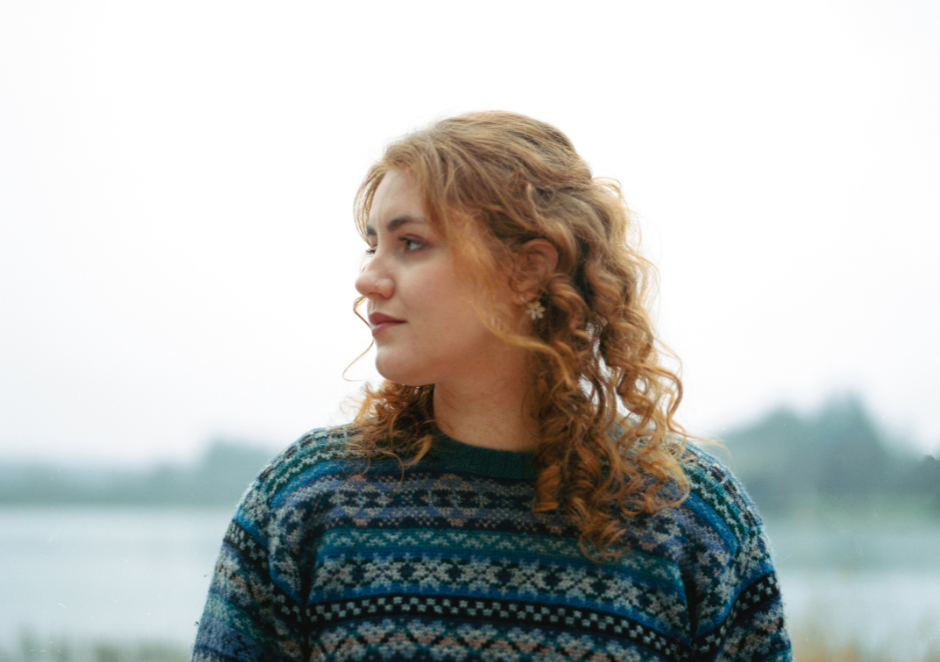
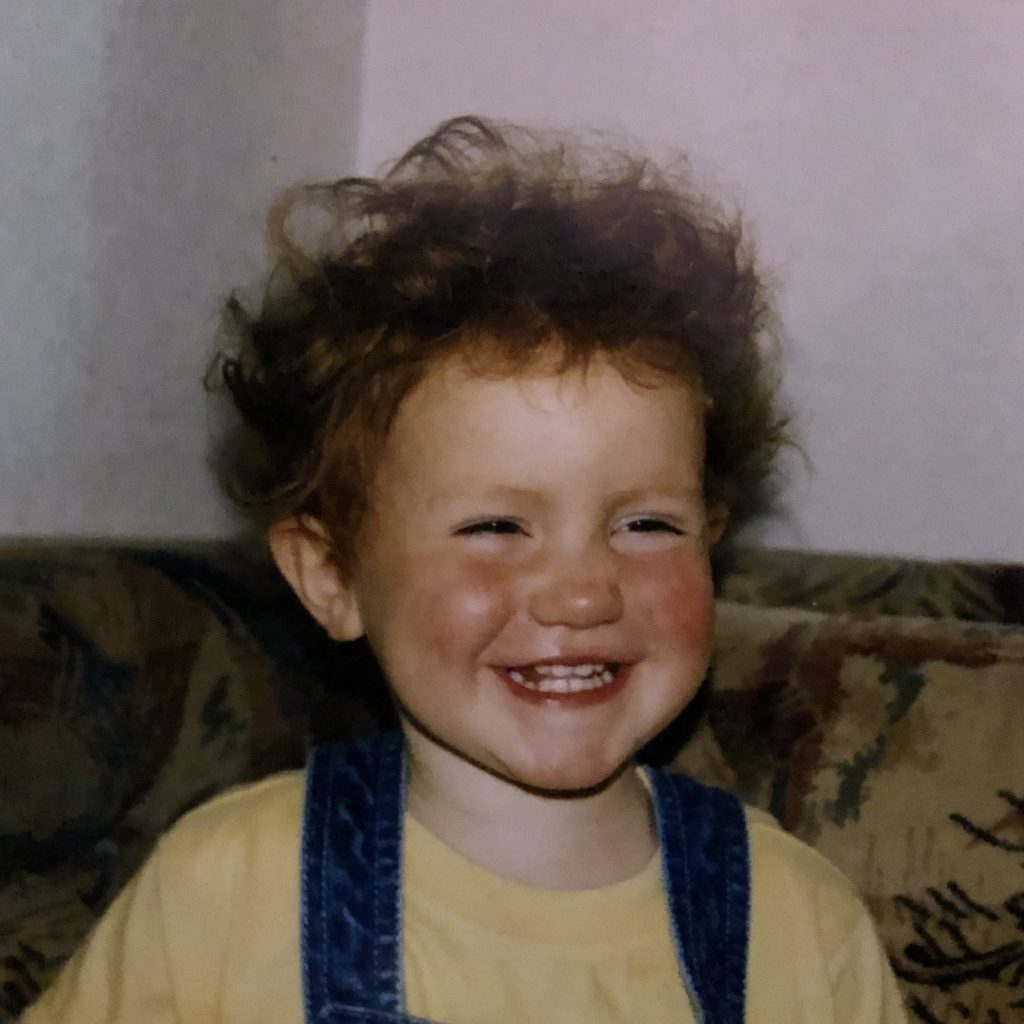
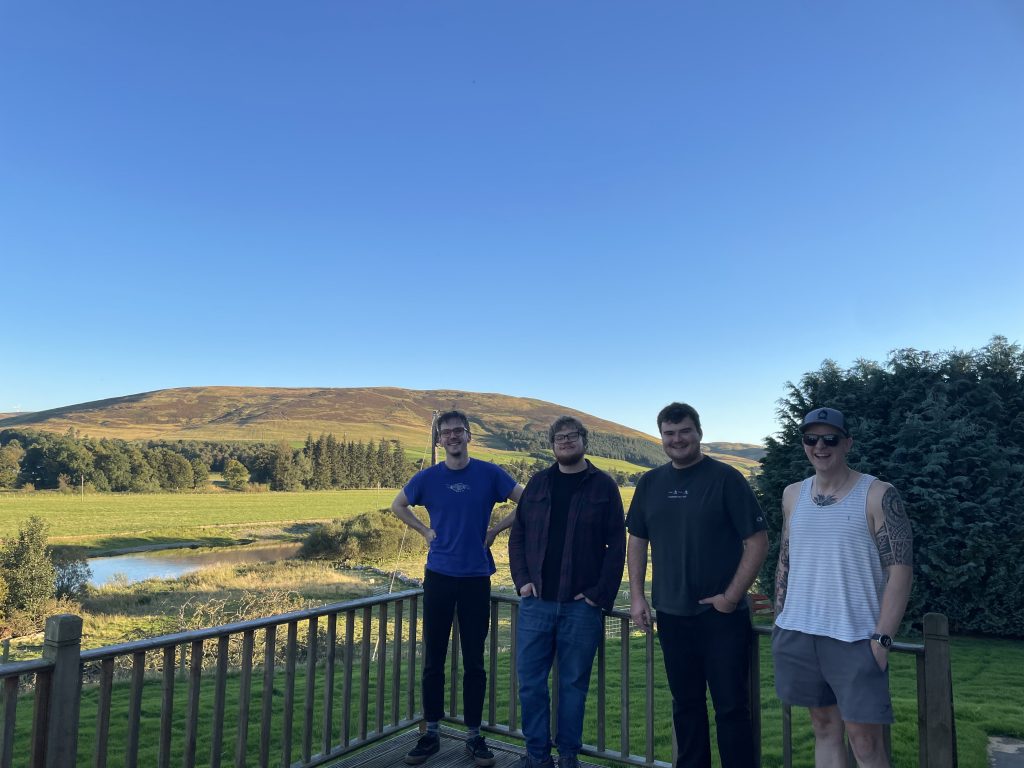 Photo taken at Gran’s House Studio, September 2024 (left to right: Dan Brown, Sam Mabbett, Callum Convoy, Chris Waite)
Photo taken at Gran’s House Studio, September 2024 (left to right: Dan Brown, Sam Mabbett, Callum Convoy, Chris Waite)

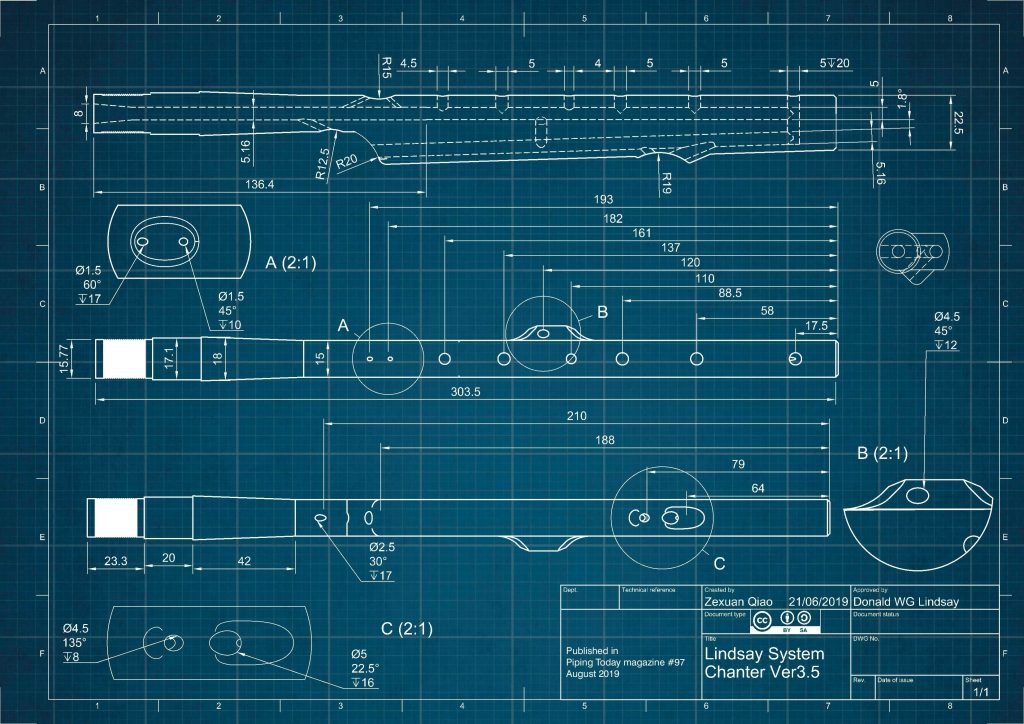 Blueprint: Draft drawing by Zexuan Qiao, based on models and data provided by Donald Lindsay. Originally typeset, colour graded, and published in Piping Today (issue 97).
Blueprint: Draft drawing by Zexuan Qiao, based on models and data provided by Donald Lindsay. Originally typeset, colour graded, and published in Piping Today (issue 97).